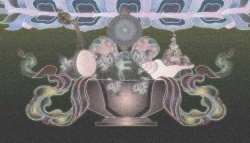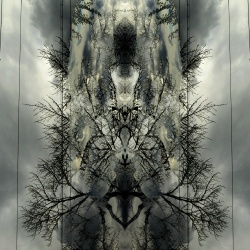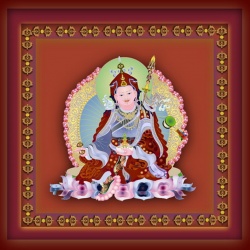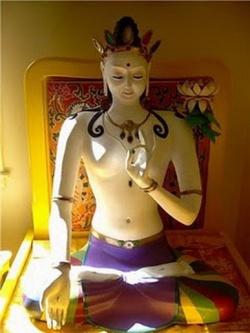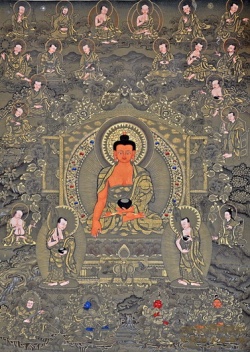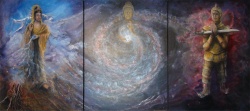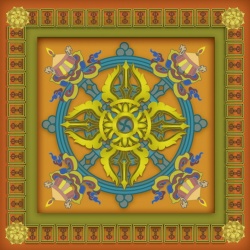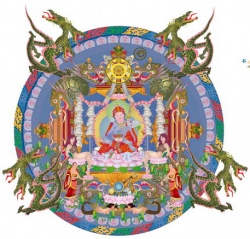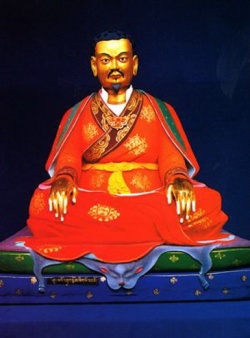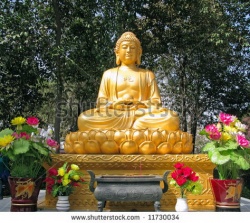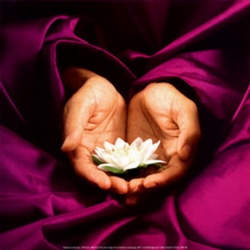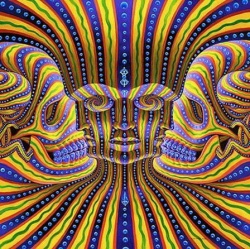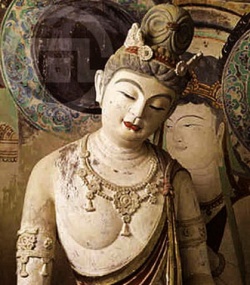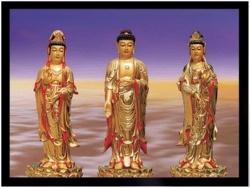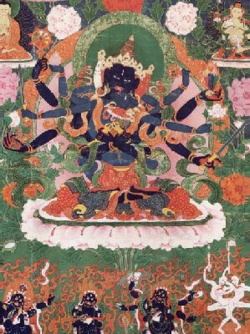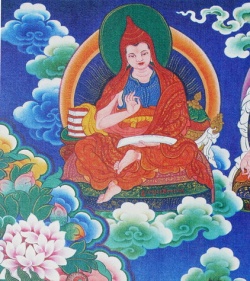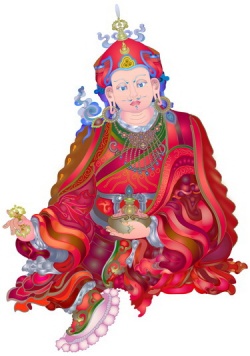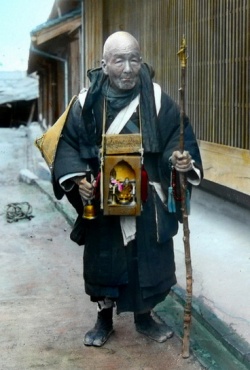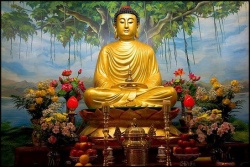Difference between revisions of "A Short Teaching about Chöd"
| Line 1: | Line 1: | ||
{{DisplayImages|1907|1259|1563|346|1440|1416|68|680|865|38|777|1122|121|1785|1850|719|1362|1566|350|961|1002|1278|774|1056|1011}} | {{DisplayImages|1907|1259|1563|346|1440|1416|68|680|865|38|777|1122|121|1785|1850|719|1362|1566|350|961|1002|1278|774|1056|1011}} | ||
<poem> | <poem> | ||
| + | |||
| + | |||
| + | |||
| + | |||
| + | |||
| + | |||
| + | |||
| + | |||
edited & arranged by [[Gaby Hollmann]] | edited & arranged by [[Gaby Hollmann]] | ||
| Line 10: | Line 18: | ||
[[Vajrayana]] was introduced gradually to [[Tibet]]. It developed and was practiced according to the [[Eight Chariots of Accomplishment]]. Many historical documents [[state]] that [[gcöd]] (pronounced [[chöd]]) belongs to the sixth practice [[lineage]], which is called [[zhi-byed]] in [[Tibetan]], ‘the [[peacemaking lineage]].’ [[Shije]] was a [[school of great masters]] who emphasized pacification of any kinds of negativities. It was a [[lineage]] of [[scholars]] and [[saints]] who integrated [[Sutrayana]] and [[Tantrayana]] in [[Buddhism]]. | [[Vajrayana]] was introduced gradually to [[Tibet]]. It developed and was practiced according to the [[Eight Chariots of Accomplishment]]. Many historical documents [[state]] that [[gcöd]] (pronounced [[chöd]]) belongs to the sixth practice [[lineage]], which is called [[zhi-byed]] in [[Tibetan]], ‘the [[peacemaking lineage]].’ [[Shije]] was a [[school of great masters]] who emphasized pacification of any kinds of negativities. It was a [[lineage]] of [[scholars]] and [[saints]] who integrated [[Sutrayana]] and [[Tantrayana]] in [[Buddhism]]. | ||
| − | The {{Wiki|purpose}} of every single practice in [[Sutrayana]] is to develop [[wisdom-awareness]] and [[compassion]], which eradicate [[ignorance]] and [[mental]] [[obscurations]] (such as [[aggression]], [[attachment]], etc.). The {{Wiki|purpose}} of every single practice in [[Tantrayana]] is to [[transform]] [[ignorance]] and negative [[mental]] [[obscurations]] into meaningful qualities; therefore it is also a peace-making practice. Four types of [[activities]] are achieved by engaging in this unified system. They are (1) pacifying sicknesses, {{Wiki|obstacles}}, [[mental]] [[obscurations]], and [[ignorance]]; (2) enriching [[merit]], [[life span]], {{Wiki|prosperity}}, and [[wisdom]]; (3) bringing the [[spiritual]] qualities, [[life force]], and all the powerful energies under control; and (4) subjugating outer and inner negative forces. But, the overall meaning of [[zhi-byed]] (pronounced [[shi-je]]) is ‘[[to pacify]].’ | + | The {{Wiki|purpose}} of every single practice in [[Sutrayana]] is to develop [[wisdom-awareness]] and [[compassion]], which eradicate [[ignorance]] and [[mental]] [[obscurations]] (such as [[aggression]], [[attachment]], etc.). The {{Wiki|purpose}} of every single practice in [[Tantrayana]] is to [[transform]] [[ignorance]] and negative [[mental]] [[obscurations]] into meaningful qualities; therefore it is also a peace-making practice. |
| + | |||
| + | Four types of [[activities]] are achieved by engaging in this unified system. They are (1) pacifying sicknesses, {{Wiki|obstacles}}, [[mental]] [[obscurations]], and [[ignorance]]; (2) enriching [[merit]], [[life span]], {{Wiki|prosperity}}, and [[wisdom]]; (3) bringing the [[spiritual]] qualities, [[life force]], and all the powerful energies under control; and (4) subjugating outer and inner negative forces. But, the overall meaning of [[zhi-byed]] (pronounced [[shi-je]]) is ‘[[to pacify]].’ | ||
| + | |||
| − | |||
| − | + | The great [[Indian]] [[Bodhisattva]] [[Padampa Sangye]], who lived in the 11th-12th century, is the [[principal]] [[teacher]] and therefore the father of the [[Shije Lineage]]. Many historical texts mention that his other [[name]] was [[Kamalashila]], so they were closely connected. [[Padampa Sangye]] brought [[Shije]] to [[Tibet]] and described it in the title of the [[ritual]] text he composed, which is [[Dam-chös-dug-näl- | |
| − | + | zhi-byed-byed-pa]] - The [[Profound Dharma that Pacifies Suffering]]. He visited [[Tibet]] five times, entering from a different [[direction]] on each visit (from the area that is now Afghanistan/Pakistan, from [[India]], from [[Nepal]], and so forth). [[Padampa Sangye]] transmitted this [[lineage]] to many great {{Wiki|male}} and {{Wiki|female}} practitioners who became accomplished [[masters]] - 54 in all. He did not invent [[Shije]] but based it on the [[Sutras]] and [[Tantras]]. | |
| − | |||
| − | Even if a [[teacher]] tries to instruct a [[student]] who isn’t ready, or even if a [[student]] who isn’t ready tries to be instructed, or even if a [[teacher]] tricks a [[disciple]] to instruct another follower, or even if a [[student]] tricks a [[teacher]] to receive the teachings, it won’t work. A [[disciple]] needs to be ready in order to be a [[worthy]] recipient of the [[secret instructions]]. So, there are three types of instructions, [[shes]], [[sgrub]], and [[gsangs]], ‘[[intellectual]] instructions, practice instructions, and [[secret instructions]]. The [[sacred]] [[lineage]] is passed on through these three [[methods]], as in all [[Vajrayana]] [[lineages]]. The [[Shije Lineage]] was held by 25 great [[masters]]. One [[master]] was called [[Crazy Jokro]] - his surname was [[Jokro]], his {{Wiki|real}} [[name]] was Mr. [[Crazy]]. There is [[nothing]] great about being crazy, but I think he must have been crazy in the right way, i.e., properly crazy. There were 24 women and a few more who developed {{Wiki|perfect}} [[realization]], upholding and transmitting the [[precious]] [[Shije Lineage]] to their [[disciples]]. | + | |
| + | In the main text of [[Shije]], the [[Dam-chös-dug-näl-zhi-byed-byed-pa]], he compiled the topics on pacification that he found scattered in the [[Sutras]] and [[Tantras]] and that were initially imparted by [[Lord Buddha]]. The school has completely disappeared, though the practice of | ||
| + | |||
| + | [[chöd]] has survived. To illustrate what it means to condense a vast [[body]] of teachings so concisely, the larger version of the [[Prajnaparamitasutra]] consists of 100,000 [[slokas]] (each [[sloka]] or verse having four sentences), the middle-length version consists of 25,000 [[slokas]], another version consists of 18,000 [[slokas]], and a shorter version is written in 8,000 verses. | ||
| + | |||
| + | |||
| + | |||
| + | The [[Heart Sutra]] is the very short version of the [[Prajanaparamitasutra]]. There are many other [[Mahayana teachings]] on [[insight]] into [[emptiness]], which are all associated with the [[Second Turning of the Wheel of Dharma]]. The [[Prajnaparamitasutra]] is the source for the [[Dam-chös-dug-näl-zhi-byed-byed-pa]] - The [[Profound Dharma that Pacifies Suffering]]. This applies to the great [[tantric text]] [[Chu-rinchen- po-rgyüd]], too. The [[Chu-rin-chen-po-rgyüd]] - The [[Precious and Great Stream of Tantra]] explains how the [[Sanskrit]] [[language]] arose from | ||
| + | |||
| + | [[nothing]]. This treatise expounds that the [[sound]] that arises from [[nothing]] is [[AH]]. And the [[sound]] that arises from [[nothing]] is the source of all {{Wiki|sounds}} that can be made by animate [[beings]] and [[inanimate]] things, i.e., every [[sound]] that can be made or that can arise is based upon [[AH]]. If it is missing, no [[sound]] can follow. The [[Precious]] and Great Stream of [[Tantra]] describes [[Wikipedia:Absolute (philosophy)|ultimate]] [[nothingness]] of {{Wiki|vowels}} and {{Wiki|consonants}} that can be investigated through {{Wiki|linguistics}}. | ||
| + | |||
| + | |||
| + | [[AH]] is the expression of [[nothingness]] when it becomes [[manifest]] as [[sound]]. In the same [[manner]], all [[Tantras]] that deal with [[Mahamudra]] are the [[principal]] source of [[Shije]]. After having briefly contemplated the sources of the [[sacred]] [[Shije Lineage]], it is important to [[respect]] and honour the great [[masters]] who have handed down the instructions to us and then to study its aspects. General | ||
| + | |||
| + | [[Shije]] is [[taught]] on an [[intellectual]] and experiential level through [[shes-pa]]-[[instructions]] and [[sgrub-pa]]-[[transmissions]]. Shes means ‘[[can be known]], [[knowledge]], [[recognition]], [[intelligence]], to be {{Wiki|aware}} of, to [[master]], [[wisdom]]-[[awareness]], [[prajna]] in [[Sanskrit]].’ [[sGrub]] means ‘[[to acquire]], to obtain, to work for, to practice, to proceed and accomplish, to fulfil, establish, finish, complete.’ [[Secret instructions]] are also given, but only if a [[disciple]] is receptive and ready. | ||
| + | |||
| + | |||
| + | |||
| + | Even if a [[teacher]] tries to instruct a [[student]] who isn’t ready, or even if a [[student]] who isn’t ready tries to be instructed, or even if a [[teacher]] tricks a [[disciple]] to instruct another follower, or even if a [[student]] tricks a [[teacher]] to receive the teachings, it won’t work. A [[disciple]] needs to be ready in order to be a [[worthy]] recipient of the [[secret instructions]]. So, there are three types of instructions, [[shes]], [[sgrub]], and [[gsangs]], ‘[[intellectual]] instructions, practice instructions, and [[secret instructions]]. The | ||
| + | |||
| + | [[sacred]] [[lineage]] is passed on through these three [[methods]], as in all [[Vajrayana]] [[lineages]]. The [[Shije Lineage]] was held by 25 great [[masters]]. One [[master]] was called [[Crazy Jokro]] - his surname was [[Jokro]], his {{Wiki|real}} [[name]] was Mr. [[Crazy]]. There is [[nothing]] great about being crazy, but I think he must have been crazy in the right way, i.e., properly crazy. There were 24 women and a few more who developed {{Wiki|perfect}} [[realization]], upholding and transmitting the [[precious]] [[Shije Lineage]] to their [[disciples]]. | ||
| + | |||
You will remember that [[chöd]] belongs to the [[Shije Tradition]] that was brought to [[Tibet]] by [[Padampa Sangye]]. He passed on the [[sacred]] teachings to one of his most devoted {{Wiki|female}} [[disciples]], [[Machig Labji Drönma]], [[Ma-gchig Lab-sGrön]] in [[Tibetan]]. [[Ma-gchig]] means ‘[[only mother]],’ [[Lab]] is the [[name]] of the town of her [[birth]] in [[Tibet]], and [[sgron]] means ‘[[lamp]], [[lantern]].’ So her [[name]] is [[Only Mother Lamp]]. Both [[Lord Buddha]] as well as [[Guru Rinpoche]], [[Padmasambhava]], prophesied in [[Sutras]] and [[Tantras]] that [[Prajnaparamita]], the [[Great Mother of Emptiness]], would be born inseparably united with [[Tara]], the [[Great Mother of Compassion]]. | You will remember that [[chöd]] belongs to the [[Shije Tradition]] that was brought to [[Tibet]] by [[Padampa Sangye]]. He passed on the [[sacred]] teachings to one of his most devoted {{Wiki|female}} [[disciples]], [[Machig Labji Drönma]], [[Ma-gchig Lab-sGrön]] in [[Tibetan]]. [[Ma-gchig]] means ‘[[only mother]],’ [[Lab]] is the [[name]] of the town of her [[birth]] in [[Tibet]], and [[sgron]] means ‘[[lamp]], [[lantern]].’ So her [[name]] is [[Only Mother Lamp]]. Both [[Lord Buddha]] as well as [[Guru Rinpoche]], [[Padmasambhava]], prophesied in [[Sutras]] and [[Tantras]] that [[Prajnaparamita]], the [[Great Mother of Emptiness]], would be born inseparably united with [[Tara]], the [[Great Mother of Compassion]]. | ||
| + | |||
[[Machig Labdrön]] is the 107th [[incarnation]] of [[Prajnaparamita]] inseparably united with [[Arya Tara]]. I don’t know how this is counted unless [[Prajnaparamita]] and [[Arya Tara]] always [[incarnated]] at the same [[time]]. Maybe they lived a long [[time]] ago, [[died]], and were [[reborn]], etc. in a [[Wikipedia:Convention (norm)|conventional]] [[manner]]. In any case, in the [[rDo-tang-nyik-byed-pa-Sutra]] it is mentioned that [[tang]] and [[nyik]] will become [[inseparable]], [[tang]] meaning ‘[[tea]]’ and [[nyik]] meaning ‘[[leaves]].’ The [[name]] of this [[Sutra]] is not [[Tea Strainer]] but refers to the process. | [[Machig Labdrön]] is the 107th [[incarnation]] of [[Prajnaparamita]] inseparably united with [[Arya Tara]]. I don’t know how this is counted unless [[Prajnaparamita]] and [[Arya Tara]] always [[incarnated]] at the same [[time]]. Maybe they lived a long [[time]] ago, [[died]], and were [[reborn]], etc. in a [[Wikipedia:Convention (norm)|conventional]] [[manner]]. In any case, in the [[rDo-tang-nyik-byed-pa-Sutra]] it is mentioned that [[tang]] and [[nyik]] will become [[inseparable]], [[tang]] meaning ‘[[tea]]’ and [[nyik]] meaning ‘[[leaves]].’ The [[name]] of this [[Sutra]] is not [[Tea Strainer]] but refers to the process. | ||
| − | |||
| − | In the [[Tantra]] called ‘[[Jam-dpäl-rtsa-ba’i-rgyüd]] - The [[Manjushri Root Tantra]], [[Lord Buddha]] prophesied: “When my teachings become like a teal eaf, the [[Great Mother]] will be born and her [[name]] will be [[Labdrön]]. Her [[activities]] will be very far-reaching. Anyone who has anything to do with her will be {{Wiki|liberated}}.” In the [[Tantra]] called [[Tenpa-spyir-lung]] - The [[General Prophecy in Buddha’s Teachings]], [[Guru Rinpoche]] stated, “An [[incarnation]] called [[Labji Drönma]] will practice in the district of [[Zangs-ri]] and cut through all negative [[thoughts]], uprooting them completely. She will cut discursiveness off so finely that negative [[thoughts]] will be without [[roots]] and will never arise again.” [[Zangs-ri]], the ‘[[Copper Coloured Mountain]],’ is a specific site in [[Tibet]] associated with [[Machig Labdrön]]. | + | In this [[Sutra]], [[Lord Buddha]] prophesied, “When mankind is in great need in {{Wiki|future}} times, the [[Mother of the Glorious Ones]] will [[incarnate]] in a place called [[Lab]] in the [[north]]. Her [[name]] will be [[Drönma]] and she will [[benefit]] {{Wiki|innumerable}} [[living beings]] through the [[generation and completion]] phases of [[visualization]] practice. She will wander in towns and {{Wiki|cemeteries}}.” The description “[[Mother of the Glorious Ones]]” refers to [[Prajnaparamita]] and [[Tara]] since both [[wisdom]] as well as [[compassion]] give |
| + | |||
| + | [[birth]] to [[Wikipedia:Absolute (philosophy)|ultimate]] [[awakening]], which is [[enlightenment]]. [[Machig Labji Drönma]] (who was born in 1055 C.E.) was [[recognized]] as the [[person]] referred to in this {{Wiki|prophecy}} - her [[name]] was [[Drönma]], the place of her [[birth]] was Lab, and she wandered in towns and {{Wiki|cemeteries}} while practicing [[generation and completion]] phases of [[meditation]]. They are quite advanced practices. | ||
| + | |||
| + | |||
| + | In the [[Tantra]] called ‘[[Jam-dpäl-rtsa-ba’i-rgyüd]] - The [[Manjushri Root Tantra]], [[Lord Buddha]] prophesied: “When my teachings become like a teal eaf, the [[Great Mother]] will be born and her [[name]] will be [[Labdrön]]. Her [[activities]] will be very far-reaching. Anyone who has anything to do with her will be {{Wiki|liberated}}.” In the [[Tantra]] called [[Tenpa-spyir-lung]] - The [[General Prophecy in Buddha’s | ||
| + | |||
| + | Teachings]], [[Guru Rinpoche]] stated, “An [[incarnation]] called [[Labji Drönma]] will practice in the district of [[Zangs-ri]] and cut through all negative [[thoughts]], uprooting them completely. She will cut discursiveness off so finely that negative [[thoughts]] will be without [[roots]] and will never arise again.” [[Zangs-ri]], the ‘[[Copper Coloured Mountain]],’ is a specific site in [[Tibet]] associated with [[Machig Labdrön]]. | ||
| + | |||
After having practiced and perfectly [[realized]] the [[chöd]] teachings, [[Machig Labdrön]] transmitted the instructions in a slightly altered [[form]]. | After having practiced and perfectly [[realized]] the [[chöd]] teachings, [[Machig Labdrön]] transmitted the instructions in a slightly altered [[form]]. | ||
| Line 42: | Line 80: | ||
The last type of [[chöd]] can falsely be seen as something like {{Wiki|exorcism}}, which does [[sound]] a little frightening. | The last type of [[chöd]] can falsely be seen as something like {{Wiki|exorcism}}, which does [[sound]] a little frightening. | ||
| − | |||
| − | If A, who is strong but negative, gets together with B, who is weak, then A [[influences]] and changes B. Then both are negative and we say that A is a bad [[friend]]. In the same way, when a [[person]] {{Wiki|unconsciously}} develops a [[connection]] to a [[spirit]], it can be good or bad. If the [[spirit]] is negative, then the [[person]] connected with that [[spirit]] will become negative. If they are connected to each other quite closely, that [[person]] can even lose his or her [[own]] will to the influence and control of the bad [[spirit]] for a certain period of [[time]]. The same [[principle]] applies to an {{Wiki|environment}} or house. A strong and good [[person]] wants to [[experience]] a good [[spirit]] in his or her {{Wiki|environment}} and house. If a house, for example, stands under the influence of a negative [[spirit]] who is [[animus]] towards the inhabitant, the house will be [[experienced]] as negative. How can the one be separated from the other? Of course, there is a negative way to deal with this, which I interpret as {{Wiki|exorcism}}. | + | [[Chöd]] is a gentle approach and improves a particular {{Wiki|environment}} peacefully. What really happens when a place seems haunted or someone seems possessed? This points to a negative [[connection]] between the [[person]] and the [[spirit]] or [[ghost]] that is haunting a house or a place. When a negative force in a certain place possesses someone, something terrible may have occurred there. It is important to understand that |
| + | |||
| + | not everyone who is crazy is possessed, although a few who are very negative are. If so, it points to a negative [[connection]] between the victim, who is a [[human being]], and another [[sentient being]], which is neither a [[human being]] nor an [[animal]], rather is a [[spirit]], [[ghost]], {{Wiki|demon}}, or whatever. When friends have a good [[connection]], they help each other. For instance, if [[person]] A is better off than [[person]] B, then A will help B and we call that being a [[good friend]]. | ||
| + | |||
| + | |||
| + | If A, who is strong but negative, gets together with B, who is weak, then A [[influences]] and changes B. Then both are negative and we say that A is a bad [[friend]]. In the same way, when a [[person]] {{Wiki|unconsciously}} develops a [[connection]] to a [[spirit]], it can be good or bad. If | ||
| + | |||
| + | the [[spirit]] is negative, then the [[person]] connected with that [[spirit]] will become negative. If they are connected to each other quite closely, that [[person]] can even lose his or her [[own]] will to the influence and control of the bad [[spirit]] for a certain period of [[time]]. The same [[principle]] applies to an {{Wiki|environment}} or house. A strong and good [[person]] wants to [[experience]] a good [[spirit]] in his | ||
| + | |||
| + | or her {{Wiki|environment}} and house. If a house, for example, stands under the influence of a negative [[spirit]] who is [[animus]] towards the inhabitant, the house will be [[experienced]] as negative. How can the one be separated from the other? Of course, there is a negative way to deal with this, which I interpret as {{Wiki|exorcism}}. | ||
| + | |||
| + | |||
| + | |||
| + | But there is also a gentle way, which is to tame and pacify the [[spirit]]. Why is there a [[frustrating]] and [[painful]] [[connection]] between persons and places to begin with? [[Suffering]] that arises from negative [[causes]] and [[conditions]] is always felt and [[experienced]] in one | ||
| + | |||
| + | way or another. By practicing the third type of [[chöd]], which is purifying an {{Wiki|environment}} of negative [[influences]] and forces, harmful [[spirits]] residing there become positive. Whatever [[caused]] [[suffering]] that drives [[spirits]] or [[ghosts]] to be revengeful and to inflict {{Wiki|frustration}} and [[pain]] on others is pacified through the practice of [[chöd]]. The practice of [[chöd]] purifies negative relationships between persons and places. | ||
| + | |||
| + | |||
| + | [[Machig Labdrön’s]] [[realization]] of [[chöd]] is [[exceptional]] and very [[precious]], the [[reason]] why [[Tibetan]] [[scholars]] and [[masters]] honour and revere her so highly and fervently practice [[chöd]] that she received from [[Padampa Sangye]] and explained so concisely. Now you understand the source of the [[chöd]] teachings, the original [[lineage]] called “[[Shije Mother Lineage]]” that branched into the [[Chöd | ||
| + | |||
| + | Lineage]]. The practice of [[chöd]] embraces all aspects of [[Tibetan Buddhism]], even if this does not seem evident. [[Chöd]] is deeply related with [[Theravada]] and [[Mahayana]] and is founded upon these very {{Wiki|sincere}} schools of practice. To clarify this point: An {{Wiki|adept}} | ||
| + | |||
| + | must have developed [[mindfulness]] and [[awareness]] of [[body]], {{Wiki|speech}}, and [[mind]] to a noteworthy extent, thereby having paved the ground in order to proceed and practice [[chöd]]. This is very important. It would not be right to simply think that someone who is a [[chöd]] [[practitioner]] need not be [[mindful]] or {{Wiki|aware}}. | ||
| + | |||
| + | |||
| − | + | It would not be right to think that just because the [[name]] of a great [[lineage-holder]] was Mr. Crazy, anyone who has received [[chöd]] instructions may act crazy, by carrying a [[skull cup]], blowing a {{Wiki|trumpet}}, and wandering around the country unkempt and sloppy. Developing [[mindfulness]] and [[awareness]] is the ground upon which an earnest [[practitioner]] walks. [[Actions]] that are based upon | |
| − | [[ | + | [[mindfulness]] and [[awareness]] come first and have to do with the outer aspect of practice. The inner aspect of [[chöd]] can be compared with contents in a container, the outer container being a [[practitioner]] who is doing what is possible to {{Wiki|perfect}} [[mindfulness]] and [[awareness]] as well as to develop and increase his or her {{Wiki|sincere}} [[intention]]. [[Actions]] are outer resources; {{Wiki|intentions}} are contents inside a container. Good {{Wiki|intentions}} make an [[action]] more valid, more {{Wiki|real}}. |
| − | |||
| − | A [[tantric]] [[practitioner]] of [[chöd]] should also have taken and uphold the basic [[tantric samayas]], ‘the [[precepts]] and pledges to attain [[awakening]] for the sole [[benefit]] of others.’ It is not possible to practice [[chöd]] without having taken the [[vows]] and without having received the [[transmission]]. It is impossible to become a [[chöd]] [[practitioner]] by merely reading a [[book]] about it. If one [[thinks]] it is okay to practice [[chöd]] without having received the [[transmission]], then there is the great possibility of getting everything wrong. The invaluable [[transmission]] supports {{Wiki|benevolent}} {{Wiki|behaviour}} and {{Wiki|intentions}}. Practice is up to the [[disciple]] and, due to having received [[transmission]], anything that he or she does not manage to {{Wiki|perfect}} is not a mistake but is understood as something that has not yet been perfected. Without the [[transmission]], though, [[thinking]] one can practice [[chöd]] is a big mistake. So, the [[Theravada]] level of practice (that is part and parcel of [[chöd]]) is outer [[discipline]]. | + | A [[tantric]] [[practitioner]] of [[chöd]] should also have taken and uphold the basic [[tantric samayas]], ‘the [[precepts]] and pledges to attain [[awakening]] for the sole [[benefit]] of others.’ It is not possible to practice [[chöd]] without having taken the [[vows]] and without having received the [[transmission]]. It is impossible to become a [[chöd]] [[practitioner]] by merely reading a [[book]] about it. If one [[thinks]] it |
| + | |||
| + | is okay to practice [[chöd]] without having received the [[transmission]], then there is the great possibility of getting everything wrong. The invaluable [[transmission]] supports {{Wiki|benevolent}} {{Wiki|behaviour}} and {{Wiki|intentions}}. Practice is up to the [[disciple]] and, due to | ||
| + | |||
| + | having received [[transmission]], anything that he or she does not manage to {{Wiki|perfect}} is not a mistake but is understood as something that has not yet been perfected. Without the [[transmission]], though, [[thinking]] one can practice [[chöd]] is a big mistake. So, the [[Theravada]] level of practice (that is part and parcel of [[chöd]]) is outer [[discipline]]. | ||
| + | |||
The [[Mahayana]] level of practice (that is part and parcel of [[chöd]]) is inner [[discipline]]. The [[tantric]] level of practice (that is part and parcel of [[chöd]]) is having [[samaya]] and [[transmission]]. [[Samaya]] is deep [[devotion]] and unremitting commitment and is the core of the entire practice - it makes things happen and guarantees that things work. A [[chöd]] [[practitioner]] needs to integrate all three levels right from the start, which improve and grow through practice. And the improvements do lead to unification of [[wisdom]] and [[compassion]]. | The [[Mahayana]] level of practice (that is part and parcel of [[chöd]]) is inner [[discipline]]. The [[tantric]] level of practice (that is part and parcel of [[chöd]]) is having [[samaya]] and [[transmission]]. [[Samaya]] is deep [[devotion]] and unremitting commitment and is the core of the entire practice - it makes things happen and guarantees that things work. A [[chöd]] [[practitioner]] needs to integrate all three levels right from the start, which improve and grow through practice. And the improvements do lead to unification of [[wisdom]] and [[compassion]]. | ||
| − | [[Machig Labdrön]] is the source of [[chöd]] practice. She is the [[manifestation]] of [[Prajnaparamita]], the Great Mother who gives [[birth]] to [[realization]] of [[emptiness]]. Furthermore, [[Machig Labdrön]] is also the [[manifestation]] of [[Arya]] [[Tara]], the Great Mother who gives [[birth]] to [[compassion]]. A [[chöd]] [[practitioner]] can cut through anything and therefore his or her main [[intention]] should be to unify [[understanding]] of [[emptiness]] and [[loving kindness]] and [[compassion]], just as [[Machig Labdrön]] did. Now, when engaging in [[chöd]], it is very important not to get stuck in the rhythm that is created when playing the [[drum]] and blowing the impressive {{Wiki|trumpet}}. | + | |
| + | [[Machig Labdrön]] is the source of [[chöd]] practice. She is the [[manifestation]] of [[Prajnaparamita]], the Great Mother who gives [[birth]] to [[realization]] of [[emptiness]]. Furthermore, [[Machig Labdrön]] is also the [[manifestation]] of [[Arya]] [[Tara]], the Great Mother who gives | ||
| + | |||
| + | [[birth]] to [[compassion]]. A [[chöd]] [[practitioner]] can cut through anything and therefore his or her main [[intention]] should be to unify [[understanding]] of [[emptiness]] and [[loving kindness]] and [[compassion]], just as [[Machig Labdrön]] did. Now, when engaging in [[chöd]], it is very important not to get stuck in the rhythm that is created when playing the [[drum]] and blowing the impressive {{Wiki|trumpet}}. | ||
| + | |||
It is a bit of an enchanting and mysterious practice, you know, practicing after it gets dark and in {{Wiki|cemeteries}}. It offers a chance to be different. But that is not the {{Wiki|purpose}}. It is an extremely effective method to realize the {{Wiki|inseparability}} of [[emptiness]] and [[compassion]]. Without an [[understanding]] of the {{Wiki|sincere}} [[intention]] to attain this {{Wiki|unity}}, then it can seem funny or {{Wiki|eccentric}}. That’s not good. I think such interpretations are not good at all, even if some [[people]] think they are good. | It is a bit of an enchanting and mysterious practice, you know, practicing after it gets dark and in {{Wiki|cemeteries}}. It offers a chance to be different. But that is not the {{Wiki|purpose}}. It is an extremely effective method to realize the {{Wiki|inseparability}} of [[emptiness]] and [[compassion]]. Without an [[understanding]] of the {{Wiki|sincere}} [[intention]] to attain this {{Wiki|unity}}, then it can seem funny or {{Wiki|eccentric}}. That’s not good. I think such interpretations are not good at all, even if some [[people]] think they are good. | ||
| − | How can one understand [[realization]] of the {{Wiki|unity}} of [[emptiness]] and [[compassion]], [[stong-dangsnying-rje’i-zung]]-‘[[jug]] in [[Tibetan]]? [[sTong]] means ‘[[emptiness]],’ [[snying-rje]] means ‘[[compassion]],’ [[zung-‘jug]] means ‘[[together]].’ [[sTong]] and [[snying-rje]] are like two strings – if you tie them together, they become [[inseparable]], i.e., [[understanding]] [[emptiness]] and having [[compassion]] are tied together through practice. This is the aim of [[chöd]], actually of every [[Vajrayana]] practice, but specifically of [[chöd]]. [[Emptiness]] is a valid topic of [[investigation]]; it is not that hard to understand and prove but it is unreasonable to simply reiterate that “[[Nothing]] [[exists]]. | + | |
| + | How can one understand [[realization]] of the {{Wiki|unity}} of [[emptiness]] and [[compassion]], [[stong-dangsnying-rje’i-zung]]-‘[[jug]] in [[Tibetan]]? [[sTong]] means ‘[[emptiness]],’ [[snying-rje]] means ‘[[compassion]],’ [[zung-‘jug]] means ‘[[together]].’ [[sTong]] and [[snying-rje]] are like two strings – if you tie them together, they become [[inseparable]], i.e., [[understanding]] [[emptiness]] and having [[compassion]] | ||
| + | |||
| + | are tied together through practice. This is the aim of [[chöd]], actually of every [[Vajrayana]] practice, but specifically of [[chöd]]. [[Emptiness]] is a valid topic of [[investigation]]; it is not that hard to understand and prove but it is unreasonable to simply reiterate that “[[Nothing]] [[exists]]. | ||
| + | |||
Everything is like a {{Wiki|reflection}} of the [[moon]] on [[water]]” - which is true. But if you only have that [[understanding]], then you become quite a strange [[person]]. You think that you have become impeccable when you are dead-set on your [[knowledge]]. You think you are more than impeccable. What can that be? [[Understanding]] [[emptiness]] is not enough – it’s only one side of the story. It’s like trying to clap with only one hand. You cannot clap your hands without having two hands. [[sNying-rje]], ‘[[compassion]],’ is a good thing to have. We [[feel]] sorry for someone who has [[nothing]]. We [[feel]] sorry for someone who doesn’t understand what we understand. | Everything is like a {{Wiki|reflection}} of the [[moon]] on [[water]]” - which is true. But if you only have that [[understanding]], then you become quite a strange [[person]]. You think that you have become impeccable when you are dead-set on your [[knowledge]]. You think you are more than impeccable. What can that be? [[Understanding]] [[emptiness]] is not enough – it’s only one side of the story. It’s like trying to clap with only one hand. You cannot clap your hands without having two hands. [[sNying-rje]], ‘[[compassion]],’ is a good thing to have. We [[feel]] sorry for someone who has [[nothing]]. We [[feel]] sorry for someone who doesn’t understand what we understand. | ||
| − | |||
| − | And just that is the {{Wiki|purpose}} of practicing [[Buddhism]], especially [[Vajrayana]]. The [[Wikipedia:Absolute (philosophy)|ultimate]] and [[relative]] [[truths]] are [[taught]] again and again in [[Vajrayana]] - until the teachings are carved in your [[skull]]. The [[truth]] of [[emptiness]] and [[compassion]] must go together so that your [[understanding]] of [[emptiness]] will not become a stubborn, [[philosophical]], pig-headed [[condition]]; and so that your [[compassion]] does not become an {{Wiki|obsession}}. In [[Vajrayana]], the [[relative]] and [[absolute]] [[truths]] are [[taught]] so that your [[life]] becomes balanced, so that your [[compassion]] and [[understanding]] of [[emptiness]] will be more effective. By integrating [[stong-dang-snying-rje]], ‘[[emptiness]] and [[compassion]],’ you will become a fair and just [[person]] who has a [[big mind]] and not a big head on a big [[body]]. | + | We [[feel]] sorry for someone who finds something too complicating that we think is simple. Just like in the case of [[stong]], if we only have [[snying-rje]], it’s not enough – it’s only one side of the story. You may be a nice [[person]], but you may turn into a quite pushy nice [[person]] for others very soon. Then you become an irritating [[person]], because you but into everybody else’s business. When an |
| + | |||
| + | [[understanding]] of [[emptiness]] and [[compassion]] are tied together, both shortcomings are solved and the situation becomes healthy. In that case, you have [[compassion]], but at the same [[time]] you know that everything is [[empty]]; you know that everything is [[empty]], but at the same [[time]] you have [[compassion]]. | ||
| + | |||
| + | |||
| + | And just that is the {{Wiki|purpose}} of practicing [[Buddhism]], especially [[Vajrayana]]. The [[Wikipedia:Absolute (philosophy)|ultimate]] and [[relative]] [[truths]] are [[taught]] again and again in [[Vajrayana]] - until the teachings are carved in your [[skull]]. The [[truth]] of [[emptiness]] and [[compassion]] must go together so that your [[understanding]] of [[emptiness]] will not become a stubborn, [[philosophical]], | ||
| + | |||
| + | pig-headed [[condition]]; and so that your [[compassion]] does not become an {{Wiki|obsession}}. In [[Vajrayana]], the [[relative]] and [[absolute]] [[truths]] are [[taught]] so that your [[life]] becomes balanced, so that your [[compassion]] and [[understanding]] of [[emptiness]] will be more effective. By integrating [[stong-dang-snying-rje]], ‘[[emptiness]] and [[compassion]],’ you will become a fair and just [[person]] who has a [[big mind]] and not a big head on a big [[body]]. | ||
| + | |||
| + | |||
| + | Your [[life]] becomes complete. If someone wants to practice [[chöd]] in a most powerful place, he or she must be {{Wiki|aware}} of the fact that many things happen there; and in such situations it is not that easy to remain balanced. When unexpected things happen to someone, it seems natural to solve any problems if one has an [[understanding]] of [[emptiness]] and has [[compassion]]. If something powerful happens in a powerful place | ||
| + | |||
| + | and in a powerful [[moment]], an [[understanding]] of [[emptiness]] and [[compassion]] will enable a [[practitioner]] to handle the situation easefully. If one does not have enough [[compassion]] and [[understanding]] of [[emptiness]], then it would be better to practice the simplified version of [[chöd]] instead of the advanced version during the daytime and at home. One may not be able to handle the advanced practice, so practicing in the afternoon is okay. | ||
| − | |||
So far I have not heard about a [[chöd]] [[practitioner]] who has gone crazy, but I can [[imagine]] that if someone does the wrong thing in the wrong place or even if someone does the wrong thing in the right place, something can go wrong. One day [[Padampa Sangye]] cried very hard. His close [[disciple]] was perplexed when he saw him, because he usually looked strong and powerful. The [[disciple]] feared that something terrible must have happened and asked, “Why are you crying?” [[Padampa Sangye]] replied, “I know that this is quite a [[sad]] [[time]]. | So far I have not heard about a [[chöd]] [[practitioner]] who has gone crazy, but I can [[imagine]] that if someone does the wrong thing in the wrong place or even if someone does the wrong thing in the right place, something can go wrong. One day [[Padampa Sangye]] cried very hard. His close [[disciple]] was perplexed when he saw him, because he usually looked strong and powerful. The [[disciple]] feared that something terrible must have happened and asked, “Why are you crying?” [[Padampa Sangye]] replied, “I know that this is quite a [[sad]] [[time]]. | ||
| − | |||
| − | [[Padampa Sangye]] continued telling his [[disciple]] why he was so [[sad]] and said, “[[People]] think that someone who lies is telling the [[truth]]. [[People]] think that someone who is telling the [[truth]] is {{Wiki|lying}}. [[People]] resent those who are kindest to them and admire those who are unkind. But I have {{Wiki|hope}},” [[Padampa Sangye]] told his [[disciple]], “{{Wiki|hope}} that is like a [[star]] that shines during the daytime. There are a few practitioners who are blessed by the [[precious]], living [[lineage]]. They are blessed and therefore have the ability to overcome these most distressing things. That is my only {{Wiki|hope}}. And, my son, the [[reason]] I am crying is because I want you to know this. | + | There are [[signs]] that [[people]] in [[Tibet]] are losing the most [[precious]] thing that they have, and the most [[precious]] thing is the [[teaching]] of the [[Buddha]].” His [[disciple]] was astounded and asked, “What do you mean?” [[Padampa Sangye]] explained, “There is no need to give your [[heart]] to others in these times, because they will steal it anyway. If you give your head to someone, they will poke out your [[eyes]] |
| + | |||
| + | and give your eyeless head back to you. [[People]] are becoming more and more [[greedy]]. They are becoming so [[greedy]] that they even insist that they have the right to be rich without doing anything. [[People]] are becoming more and more embarrassed and ashamed of doing good and are | ||
| + | |||
| + | becoming more and more inspired and encouraged to do bad things.” I see that it is very fashionable to be drunk, drugged, crazy, stupid, careless, and wild and that it is considered shameful to be gentle and generous in {{Wiki|modern}} {{Wiki|society}}, too. I see more and more of this happening myself. | ||
| + | |||
| + | |||
| + | [[Padampa Sangye]] continued telling his [[disciple]] why he was so [[sad]] and said, “[[People]] think that someone who lies is telling the [[truth]]. [[People]] think that someone who is telling the [[truth]] is {{Wiki|lying}}. [[People]] resent those who are kindest to them and admire those who are unkind. But I have {{Wiki|hope}},” [[Padampa Sangye]] told his [[disciple]], “{{Wiki|hope}} that is like a [[star]] that shines | ||
| + | |||
| + | during the daytime. There are a few practitioners who are blessed by the [[precious]], living [[lineage]]. They are blessed and therefore have the ability to overcome these most distressing things. That is my only {{Wiki|hope}}. And, my son, the [[reason]] I am crying is because I want you to know this. | ||
| + | |||
I want you to be the little [[star]] that shines during the daytime and to become like the {{Wiki|sun}}.” When I look at the [[lives]] of the majority of [[people]] and outside the {{Wiki|community}} of dedicated [[Dharma]] practitioners, it becomes evident that [[Padampa Sangye’s]] words describe our {{Wiki|society}} too. It is obvious that it has become shameful to be gentle and kind, that it has become fashionable to be aggressive and sly. I think that our [[teachers]] may be saying the same things to us quite often. The connotation of the [[word]] ‘progress’ is to cut through limitations and [[attachment]], otherwise one stands still. So, any beneficial progress can be seen as a practice of cutting through. | I want you to be the little [[star]] that shines during the daytime and to become like the {{Wiki|sun}}.” When I look at the [[lives]] of the majority of [[people]] and outside the {{Wiki|community}} of dedicated [[Dharma]] practitioners, it becomes evident that [[Padampa Sangye’s]] words describe our {{Wiki|society}} too. It is obvious that it has become shameful to be gentle and kind, that it has become fashionable to be aggressive and sly. I think that our [[teachers]] may be saying the same things to us quite often. The connotation of the [[word]] ‘progress’ is to cut through limitations and [[attachment]], otherwise one stands still. So, any beneficial progress can be seen as a practice of cutting through. | ||
| − | In [[chöd]], the process is exaggerated slightly in order to {{Wiki|emphasize}} and [[stress]] cutting through. There are [[three ways]] to cut through as [[taught]] in [[chöd]]. They are the external, the internal, and the [[sacred]] ways. (1) Externally, there are many things that prevent us from developing, i.e., something out there distracts and overwhelms one’s [[mind]] so strongly that one is obscured from doing what needs to be done in order to progress and become a better [[human being]]. Basic [[Buddhist]] instructions say that being aggressive and sly in order to dissever a [[connection]] intensifies it negatively. By practicing [[chöd]], though, [[causes]] and [[conditions]] which link are [[transformed]] positively. One may succeed very fast, if not, then slowly and gradually. | + | |
| + | |||
| + | In [[chöd]], the process is exaggerated slightly in order to {{Wiki|emphasize}} and [[stress]] cutting through. There are [[three ways]] to cut through as [[taught]] in [[chöd]]. They are the external, the internal, and the [[sacred]] ways. (1) Externally, there are many things that prevent us from developing, i.e., something out there distracts and overwhelms one’s [[mind]] so strongly that one is obscured from doing what needs to be | ||
| + | |||
| + | done in order to progress and become a better [[human being]]. Basic [[Buddhist]] instructions say that being aggressive and sly in order to dissever a [[connection]] intensifies it negatively. By practicing [[chöd]], though, [[causes]] and [[conditions]] which link are [[transformed]] positively. One may succeed very fast, if not, then slowly and gradually. | ||
| + | |||
In any case, [[chöd]] is an extremely reliable technique to skillfully overcome negative connections that were made in the {{Wiki|past}} without perpetuating more negativity. They cannot be overcome by rejecting or denying them nor through wishful [[thinking]]. (2) Internally, there are many {{Wiki|obstacles}}, too. Outer {{Wiki|obstacles}} are more obvious than inner ones. What is apprehended (outer) is connected with the apprehend-er (inner). [[Acknowledging]] and appreciating the fact that one is not the [[embodiment]] of inner {{Wiki|obstacles}} but the [[embodiment]] of [[enlightened]] [[wisdom]] is the antidote against inner {{Wiki|obstacles}}. | In any case, [[chöd]] is an extremely reliable technique to skillfully overcome negative connections that were made in the {{Wiki|past}} without perpetuating more negativity. They cannot be overcome by rejecting or denying them nor through wishful [[thinking]]. (2) Internally, there are many {{Wiki|obstacles}}, too. Outer {{Wiki|obstacles}} are more obvious than inner ones. What is apprehended (outer) is connected with the apprehend-er (inner). [[Acknowledging]] and appreciating the fact that one is not the [[embodiment]] of inner {{Wiki|obstacles}} but the [[embodiment]] of [[enlightened]] [[wisdom]] is the antidote against inner {{Wiki|obstacles}}. | ||
| − | |||
| − | The {{Wiki|syllable}} PETH has no meaning. It is not a [[word]] used in any spoken [[language]], so when it is spoken or shouted, the [[sound]] alone cuts through – at least for the [[moment]]. Since it has no meaning like other words one [[knows]] and might say, for instance the words “yes” or “no,” the [[sound]] cuts through the raw situation of that [[moment]], leaving [[space]] to [[experience]] a short [[retreat]] into what is actually {{Wiki|present}}. Afterwards, [[relative]] [[reality]] takes over again and one has returned to the [[world]] of {{Wiki|obstacles}} and [[delusions]]. The outer, inner, and [[sacred]] practices are always a part of every [[chöd]] practice, but one first starts by severing the outer, continues by severing the inner, and finally practices the [[sacred]] aspect of [[chöd]]. It is the only way to go. For instance, if one wants to get to the attic of a house, one must pass through the entrance and climb the staircase. | + | Not [[recognizing]] one’s [[true nature]] that is free of {{Wiki|obstacles}} impedes this [[recognition]], so the amount and intensity of {{Wiki|obstacles}} point to the {{Wiki|degree}} of non-recognition one has. Again, [[chöd]] is the fastest method to skillfully [[recognize]] inner [[delusions]] without aggravating and perpetuating more negative [[feelings]] that turn into a third [[obstacle]], if they are not pacified |
| + | |||
| + | beforehand. (3) The [[sacred]] aspect of [[chöd]] addresses the very topic that ultimately there are no {{Wiki|obstacles}} and relatively there are. There is the [[danger]] that the third aspect can turn into a new and major [[obstacle]]. Again, [[chöd]] is the most reliable method to skillfully cut through the first two without creating a third. How is this done? By applying the outstanding gesture of [[speech]] and {{Wiki|speaking}} the {{Wiki|syllable}} PETH. | ||
| + | |||
| + | |||
| + | The {{Wiki|syllable}} PETH has no meaning. It is not a [[word]] used in any spoken [[language]], so when it is spoken or shouted, the [[sound]] alone cuts through – at least for the [[moment]]. Since it has no meaning like other words one [[knows]] and might say, for instance the words “yes” or “no,” the [[sound]] cuts through the raw situation of that [[moment]], leaving [[space]] to [[experience]] a short [[retreat]] into what | ||
| + | |||
| + | is actually {{Wiki|present}}. Afterwards, [[relative]] [[reality]] takes over again and one has returned to the [[world]] of {{Wiki|obstacles}} and [[delusions]]. The outer, inner, and [[sacred]] practices are always a part of every [[chöd]] practice, but one first starts by severing the outer, continues by severing the inner, and finally practices the [[sacred]] aspect of [[chöd]]. It is the only way to go. For instance, if one wants to get to the attic of a house, one must pass through the entrance and climb the staircase. | ||
| + | |||
| + | |||
| + | That is how [[meditation practices]] [[function]], too. Every further practice is based upon the preceding, like the rungs of a ladder, and the [[three ways]] are always practiced in one sitting. Now I would like to share a few sequences practiced in [[chöd]] with you. One particular practice of [[chöd]] involves four steps. They are known as (1) the [[mind]] that is like a canvas of the entire [[universe]], i.e., the ground; | ||
| + | |||
| + | (2) the power of the [[chöd]] [[transmission]], i.e., the [[blessing]]; (3) the specific method to cut through the raw material; and (4) the first three in one. (1) The [[mind]] - the ground - that is like a canvas of the entire [[universe]] refers to the fact that the [[mind]] [[manifests]] [[forms]], {{Wiki|sounds}}, and [[thoughts]]. [[Forms]] are all material things that have a shape, {{Wiki|color}}, and {{Wiki|texture}} and that | ||
| + | |||
| + | can be seen or [[perceived]]. {{Wiki|Sounds}} are the movements that [[forms]] make and that can be heard. [[Thoughts]] are [[Wikipedia:concept|concepts]] that are created in the [[mind]] when a [[form]] is felt or seen or when a [[sound]] is heard. | ||
| + | |||
| − | + | This process describes how everything [[exists]] – everything, right here and right now. For example, the term “[[human being]]” is designated in reliance upon a specific [[form]] (one head, two arms, two {{Wiki|legs}}, etc.). A specific plant grows here or there, sheep's’ fur is sheared, woven, and then tailored. The one and the other are called “[[clothes]]” when they have been made to fit and be worn by the [[form]] that is called | |
| − | + | “a man” or “a woman.” We wish to pinpoint our [[thoughts]], for example when we say “[[green]] sweater,” “brown trousers,” “black shoes” – all these things are [[forms]]. We make gestures when we identify and distinguish [[forms]], {{Wiki|sounds}}, and other sensory [[perceptions]] that we {{Wiki|perceive}}, and these gestures connect the one with the other and are made through the process of {{Wiki|communication}}. [[Thoughts]] | |
| − | + | connect [[perceptions]] and [[experiences]] through movements. Having been asked to speak about [[chöd]], one corner of my [[mind]] tells me to speak about [[chöd]], while another corner of my [[mind]] looks into the [[subject]] by remembering [[books]] that I once read or by [[seeing]] the white paper and black letters inside those [[books]]. | |
| − | |||
| − | A [[disciple]] can become better, i.e., can [[transform]] through the powerful method endowed by means of the [[chöd]] [[transmission]] that an [[Wikipedia:Authenticity|authentic]] [[lineage-holder]] imparts. It is a very effective [[blessing]]. How does the [[transformation]] take place? It is not the case that negative and positive things are placed inside a [[disciple]] from the outside, rather negativity [[manifests]] positively through the power of the [[blessings]]. Now, the [[essence]] of negative things is positive, the [[essence]] of unhealthiness is [[health]]; the [[essence]] of the [[relative]] is the [[Wikipedia:Absolute (philosophy)|ultimate]]. It’s not the case that the [[relative]] comes from the outside and enters the inside of a [[student]] nor that the [[Wikipedia:Absolute (philosophy)|ultimate]] is brought from somewhere, rather [[relative]] [[appearances]] and [[experiences]] are the actual [[manifestations]] of the [[Wikipedia:Absolute (philosophy)|ultimate]]. The [[Wikipedia:Absolute (philosophy)|ultimate]] is the center, the [[relative]] is the surrounding. | + | |
| + | At the same [[time]], another corner of my [[mind]] recollects {{Wiki|sounds}} heard long ago. Some of these noise-makers are still alive in my [[mind]]; some are not as alive anymore but remain in my [[mind]]. There are lots and lots of [[forms]] that make lots and lots of {{Wiki|sounds}} that turn into lots and lots of [[thoughts]] that are [[gathered]] together right now. Not only are all apperceptions bundled in [[thoughts]], they | ||
| + | |||
| + | are also [[gathered]] in front of you, in the [[form]] of the [[person]] you see seated on this cushion, who happens to be me. The chain-reaction continues when I think, “My [[form]] … Your [[form]] … All of you.” Then I make a [[sound]] of my [[thoughts]] in order to {{Wiki|communicate}} with you, and during the whole process I am connecting with you. That is a short outline of what happens. | ||
| + | |||
| + | |||
| + | What does the {{Wiki|concept}} “the ground” mean? It is the [[mandala]], which means ‘center and surrounding.’ Every single center has a surrounding. Every single surrounding has a center. So, every single thing in the [[universe]] is a [[mandala]] of the [[mind]]. Every [[form]], every [[sound]], every [[thought]] is a [[mandala]] of the [[mind]]. [[Mind]] is the center, [[thoughts]] and {{Wiki|sounds}} are the surroundings | ||
| + | |||
| + | of the [[mind]] - and that is the ground. (2) The power of the [[chöd]] [[transmission]] - the [[blessing]] - transforms the [[mandala]] of the [[mind]] from worse to better, from negative to positive, from [[unhealthy]] to healthy, from [[relative]] to [[Wikipedia:Absolute (philosophy)|ultimate]]. | ||
| + | |||
| + | |||
| + | |||
| + | A [[disciple]] can become better, i.e., can [[transform]] through the powerful method endowed by means of the [[chöd]] [[transmission]] that an [[Wikipedia:Authenticity|authentic]] [[lineage-holder]] imparts. It is a very effective [[blessing]]. How does the [[transformation]] take place? It is not the case that negative and positive things are placed inside a [[disciple]] from the outside, rather negativity [[manifests]] positively through the power of the [[blessings]]. Now, the [[essence]] of negative things is positive, the [[essence]] of unhealthiness is [[health]]; the | ||
| + | |||
| + | [[essence]] of the [[relative]] is the [[Wikipedia:Absolute (philosophy)|ultimate]]. It’s not the case that the [[relative]] comes from the outside and enters the inside of a [[student]] nor that the [[Wikipedia:Absolute (philosophy)|ultimate]] is brought from somewhere, rather [[relative]] [[appearances]] and [[experiences]] are the actual [[manifestations]] of the [[Wikipedia:Absolute (philosophy)|ultimate]]. The [[Wikipedia:Absolute (philosophy)|ultimate]] is the center, the [[relative]] is the surrounding. | ||
| + | |||
This is one way of describing the most {{Wiki|excellent}} and profound instructions of the [[Chöd Lineage]]. (3) A specific method to cut through what is called “raw material” is to understand that [[form]] (our [[body]]), {{Wiki|sounds}} (our [[speech]]), and [[thoughts]] are all part of the [[mind]]. On a very {{Wiki|subtle}} level, [[thoughts]] and [[mind]] are different. The [[mind]] can be compared with the ocean, [[thoughts]] with the ocean’s waves. The entire ocean is not the waves, while each wave is part of the vast and deep ocean. Similarly, [[thoughts]] are the waves of the [[mind]]. | This is one way of describing the most {{Wiki|excellent}} and profound instructions of the [[Chöd Lineage]]. (3) A specific method to cut through what is called “raw material” is to understand that [[form]] (our [[body]]), {{Wiki|sounds}} (our [[speech]]), and [[thoughts]] are all part of the [[mind]]. On a very {{Wiki|subtle}} level, [[thoughts]] and [[mind]] are different. The [[mind]] can be compared with the ocean, [[thoughts]] with the ocean’s waves. The entire ocean is not the waves, while each wave is part of the vast and deep ocean. Similarly, [[thoughts]] are the waves of the [[mind]]. | ||
| − | |||
| − | + | The specific method of [[chöd]] deals with [[body]], {{Wiki|speech}}, and [[mind]]. How is the [[body]] treated properly in [[chöd]] practice? Sitting straight and respecting one’s [[body]]. [[Speech]], the other aspect, is related to the [[breath]], to what is spoken, to [[chanting]], to how closely PETH is connected with the [[mind]] when it is spoken. The first thing a [[chöd]] [[practitioner]] needs to consider is the sequence of [[meditation]] practice, which involves much [[visualization]]. One would think that cutting through involves less [[visualization]], but there are | |
| − | + | many. Most [[visualizations]] in [[chöd]] are quite [[physical]]. But there are not only [[physical]] [[visualizations]] above and in front since one’s [[own]] [[body]] is engaged intensively while practicing. For example, in a specific [[chöd]] practice, one cuts up one’s [[body]] and feeds it to all those one is negatively connected with through the [[law of karma]]; one pays back one’s debts to one’s enemies by giving them one’s flesh and {{Wiki|blood}}. | |
| − | |||
| − | Her [[kindness]] to the land of [[Tibet]] surpasses the [[imagination]] and her [[compassionate]] [[activity]], that is not different from [[Padmasambhava’s]], continues unceasingly." Now I would like to speak about a very [[sacred]] [[teaching]] that [[Machig Labdrön]] gave to her son. She told him, “There are four best things that you can [[own]]: best [[protection]], best [[accumulation]], best place, and best [[view]].” What is the best [[protection]]? [[Machig]] [[Drönma]] told her son, “The best [[protection]] is not being [[attached]] to your [[body]] and [[pleasures]]. That is the best [[protection]]. My son,” she continued, “everyone is busy protecting their [[life]], their position in [[life]], their riches, and their [[pleasures]]. If you have no [[attachment]] to these things, then there is [[nothing]] to {{Wiki|protect}}.” What is the best [[accumulation]]? [[Machig Labdrön]] told her son, “The best [[accumulation]] is becoming free of [[clinging]] to material things.” | + | Who is an enemy? Anyone who wishes to harm. If an enemy is really [[violent]] and [[evil]], he or she will even want to kill the [[person]] they [[hate]] the most. When such a most [[unvirtuous]] act has been completed, that [[evil]] enemy may even be [[happy]] and think, “Now I have beaten my foe and am rid of that [[person]].” This is not true, though, but that is what some [[people]] think. When dealing with negative connections, |
| + | |||
| + | [[nothing]] is more valuable and decisive than one’s [[body]], [[speech]], and [[thoughts]]. This is why [[chöd]] teaches how to give one’s [[own]] flesh and {{Wiki|blood}} to negative energies one is indebted to because of a [[karmic]] link. It {{Wiki|sounds}} like a rather extreme and frightening method, but those who have received the [[transmission]] understand and know that it is a very effective way of dealing with | ||
| + | |||
| + | negativities and these practitioners certainly value its worth. (4) Practicing all [[methods]] in one means preparing the ground by [[understanding]] (i.e., the preparation, the [[understanding]]), receiving the [[transmission]] (i.e., the [[blessing]]), and working with the raw material (i.e., with [[body]], [[speech]], and [[thoughts]]). | ||
| + | |||
| + | |||
| + | All [[methods]] of practice only pertain to [[relative]] [[reality]]. A [[chöd]] [[practitioner]] has learned not to see any aspect of [[relative]] [[existence]] as an [[ultimate truth]]. Aware of these facts, he or she is able to cut through the [[belief]] in the method itself, i.e., he or she will not [[cling]] to any [[Wikipedia:concept|concepts]] regarding a [[subject]], [[objects]], and [[actions]], in this case [[actions]] referring | ||
| + | |||
| + | to the practice of [[chöd]]. To illustrate this, let me quote a verse that either [[Tilopa]] or [[Naropa]] [[sang]] in a [[song of realization]]: “[[Water]] can wash away stains, but [[water]] cannot wash [[water]] itself.” Similarly, [[chöd]] can cut through all {{Wiki|obstacles}}, [[including]] the [[idea]] of practicing. | ||
| + | |||
| + | |||
| + | It is recorded that [[Machig Labdrön]] was the [[consort]] of the [[Indian]] [[master]] [[Thöpa Bhadra]]. [[Thöpa Bhadra]] was the father of her two sons and four daughters. It is also recorded that [[Machig Labdrön]] was an [[incarnation]] of [[Yeshe Tsogyal]]. [[Yeshe Tsogyal]] ([[Ye-shes-mtsho-rgyäl]], ‘[[Victorious Ocean of Wisdom]],’ the [[speech]] [[emanation]] of [[Vajravarahi]]) was [[Padmasambhava’s]] [[spiritual consort]]. In | ||
| + | |||
| + | The [[Precious Garland of Lapis Lazuli]], [[Jamgon Kongtrul Lodro Thaye]] tells us, "[[Yeshe Tsogyal]] was a direct [[incarnation]] of [[Vajrayogini]] (another [[name]] for [[Vajravarahi]]) in the [[form]] of a woman. She served [[Padmasambhava]] perfectly in that [[life]], engaged in [[sadhana]] practice with fervent perseverance and [[attained]] a level {{Wiki|equal}} to [[Padmasambhava]]. | ||
| + | |||
| + | |||
| + | |||
| + | Her [[kindness]] to the land of [[Tibet]] surpasses the [[imagination]] and her [[compassionate]] [[activity]], that is not different from [[Padmasambhava’s]], continues unceasingly." Now I would like to speak about a very [[sacred]] [[teaching]] that [[Machig Labdrön]] gave to her son. She told him, “There are four best things that you can [[own]]: best [[protection]], best [[accumulation]], best place, and best [[view]].” | ||
| + | |||
| + | What is the best [[protection]]? [[Machig]] [[Drönma]] told her son, “The best [[protection]] is not being [[attached]] to your [[body]] and [[pleasures]]. That is the best [[protection]]. My son,” she continued, “everyone is busy protecting their [[life]], their position in [[life]], their riches, and their [[pleasures]]. If you have no [[attachment]] to these things, then there is [[nothing]] to {{Wiki|protect}}.” What is the best [[accumulation]]? [[Machig Labdrön]] told her son, “The best [[accumulation]] is becoming free of [[clinging]] to material things.” | ||
| + | |||
As it is, we normally think that [[accumulation of merit]] means giving $10 to the poor, giving another $10 to the [[Guru]], donating $10 to a [[temple]], burning $10-worth of [[butter lamps]], or dropping $10 into the donation box at the entrance of a [[monastery]] or {{Wiki|welfare}} centre. It is good to use any [[wealth]] one has saved to help others, but accumulating [[merit]] means more – it means not being [[attached]] to the material [[accumulation of merit]]. When one is free of [[attachment]] to material [[accumulation of merit]], then everything one does becomes an [[accumulation of merit]]. Is it possible to use all the things one has only for oneself without being [[attached]]? | As it is, we normally think that [[accumulation of merit]] means giving $10 to the poor, giving another $10 to the [[Guru]], donating $10 to a [[temple]], burning $10-worth of [[butter lamps]], or dropping $10 into the donation box at the entrance of a [[monastery]] or {{Wiki|welfare}} centre. It is good to use any [[wealth]] one has saved to help others, but accumulating [[merit]] means more – it means not being [[attached]] to the material [[accumulation of merit]]. When one is free of [[attachment]] to material [[accumulation of merit]], then everything one does becomes an [[accumulation of merit]]. Is it possible to use all the things one has only for oneself without being [[attached]]? | ||
| + | |||
If one is not [[attached]], then even if one doesn’t give a penny to a {{Wiki|beggar}}, it is an [[accumulation of merit]]. This is why [[Machig Labdrön]] told her son how to really invest effectively and said, “The best [[accumulation of merit]] is to cut off all [[attachment]] and any [[clinging]] to material possessions.” [[Machig Labdrön]] then told her son, “Where is the best place? Not [[clinging]] to a place or location is the best place.” It is true, any place is okay. Any place is the best place if one is not [[attached]] nor clings to it. And then [[geomancy]] is not needed. | If one is not [[attached]], then even if one doesn’t give a penny to a {{Wiki|beggar}}, it is an [[accumulation of merit]]. This is why [[Machig Labdrön]] told her son how to really invest effectively and said, “The best [[accumulation of merit]] is to cut off all [[attachment]] and any [[clinging]] to material possessions.” [[Machig Labdrön]] then told her son, “Where is the best place? Not [[clinging]] to a place or location is the best place.” It is true, any place is okay. Any place is the best place if one is not [[attached]] nor clings to it. And then [[geomancy]] is not needed. | ||
| − | |||
| − | That is the best [[view]] – not being [[attached]]. There is a [[risk]] about sharing these teachings with you, especially about not being [[attached]] to a [[view]], [[seeing]] that it may lead you to overestimate yourselves. Let me explain why: It is true that one should not be [[attached]] or [[cling]] to a [[view]], but at this point in [[life]], this [[teaching]] should only be kept in the back of your head and only remembered when you become overly [[attached]] to a [[view]]. It is important to have some kind of [[view]], a [[principle]] to go by, otherwise one will go astray. Without a [[view]], one will most likely get lost. | + | That is why the greatest [[yogi]], [[Jetsün Milarepa]], was able to live in such uninhabitable places, in [[caves]] high up in the [[mountains]], in places where no single [[flower]] could possibly grow, where a kitchen [[garden]] could not be tended, nor chickens could ever be kept. The places he chose to [[meditate]] were totally useless spots. From among the many [[reasons]] he had for [[meditating]] in such unfriendly and |
| + | |||
| + | unfortified places, I think one may have been so that he would not become [[attached]]. The mother then told her boy about the best [[view]] and said, “The best [[view]] is not being [[attached]] to your [[view]].” It is very important for a [[chöd]] [[practitioner]] not to be [[attached]] to a particular [[view]]. | ||
| + | |||
| + | |||
| + | That is the best [[view]] – not being [[attached]]. There is a [[risk]] about sharing these teachings with you, especially about not being [[attached]] to a [[view]], [[seeing]] that it may lead you to overestimate yourselves. Let me explain why: It is true that one should not be | ||
| + | |||
| + | [[attached]] or [[cling]] to a [[view]], but at this point in [[life]], this [[teaching]] should only be kept in the back of your head and only remembered when you become overly [[attached]] to a [[view]]. It is important to have some kind of [[view]], a [[principle]] to go by, otherwise one will go astray. Without a [[view]], one will most likely get lost. | ||
| + | |||
Even if the [[view]] one has is not the best and one [[thinks]], “Best [[view]] is no [[view]],” it is still necessary to have a [[view]] to go by and therefore to hold on to it before trying to live according to what is called “beyond [[view]].” Therefore, do not take my words about the [[view]] to [[heart]] right now and do not get carried away by the wonderful, [[Wikipedia:Absolute (philosophy)|ultimate]] advice that [[Machig Labdrön]] gave to her son. We are dealing with a deeper level of [[relative truth]] here, therefore it’s very important to be inspired by these teachings, while maintaining and increasing {{Wiki|benevolent}} {{Wiki|intentions}} and a [[wholesome]] [[lifestyle]]. | Even if the [[view]] one has is not the best and one [[thinks]], “Best [[view]] is no [[view]],” it is still necessary to have a [[view]] to go by and therefore to hold on to it before trying to live according to what is called “beyond [[view]].” Therefore, do not take my words about the [[view]] to [[heart]] right now and do not get carried away by the wonderful, [[Wikipedia:Absolute (philosophy)|ultimate]] advice that [[Machig Labdrön]] gave to her son. We are dealing with a deeper level of [[relative truth]] here, therefore it’s very important to be inspired by these teachings, while maintaining and increasing {{Wiki|benevolent}} {{Wiki|intentions}} and a [[wholesome]] [[lifestyle]]. | ||
| − | |||
| − | I want to share the basic [[principle]] with you. I am not giving you instructions so that you think you can go out afterwards and do them. I am sharing the [[principle]] with you so that you have some [[understanding]]. The method is called “Opening the [[Heavenly]] Gate.” Normally, we are very closed down, both [[mentally]] and {{Wiki|physically}}. So the {{Wiki|purpose}} of opening the gate is to become free of restrictions and receptive for what takes place in the vast expanse of [[limitless]] [[space]]. If the door of a small room where someone has been trapped for many years is suddenly opened and this [[person]] is finally free to walk out, he or she [[experiences]] a lot of room, a lot of [[space]]. How is this practiced in [[meditation]]? | + | |
| + | All of these instructions are practiced according to one’s capabilities, according to the level of [[understanding]] one has [[attained]], while one is {{Wiki|aware}} of who one ultimately is and how things should ultimately be. So don’t get confused about these two levels of [[understanding]]. If you don’t want to be confused, it’s quite easy. If you decide to be confused, it’s difficult not to be confused. So, this is | ||
| + | |||
| + | one specific set of [[chöd]] instructions that have been handed down to us in an unbroken [[lineage]] due to [[Machig]] Labdrön’s [[inconceivable]] [[wisdom]] and immense [[generosity]]. There is a particular method [[taught]] in [[chöd]] that is quite easy and I find very effective. | ||
| + | |||
| + | |||
| + | I want to share the basic [[principle]] with you. I am not giving you instructions so that you think you can go out afterwards and do them. I am sharing the [[principle]] with you so that you have some [[understanding]]. The method is called “Opening the [[Heavenly]] Gate.” Normally, we are very closed down, both [[mentally]] and {{Wiki|physically}}. So the {{Wiki|purpose}} of opening the gate is to become free of restrictions and | ||
| + | |||
| + | receptive for what takes place in the vast expanse of [[limitless]] [[space]]. If the door of a small room where someone has been trapped for many years is suddenly opened and this [[person]] is finally free to walk out, he or she [[experiences]] a lot of room, a lot of [[space]]. How is this practiced in [[meditation]]? | ||
| + | |||
[[Chöd]] uses {{Wiki|sounds}}, [[visualizations]], and [[physical]] [[posture]] so that a [[practitioner]] is able to develop strong reflexive [[awareness]] in the center of his or her [[body]]. The center of the [[body]] is very important. If my right hand were chopped off, I would still be alive. If the center of my [[body]] were chopped off, I would be finished. The center of the [[body]] is like the trunk of a [[tree]]. It is the center of the energy-source from which the [[mind]] functions. From the [[moment]] of {{Wiki|conception}} until [[death]], we [[function]] from this center. | [[Chöd]] uses {{Wiki|sounds}}, [[visualizations]], and [[physical]] [[posture]] so that a [[practitioner]] is able to develop strong reflexive [[awareness]] in the center of his or her [[body]]. The center of the [[body]] is very important. If my right hand were chopped off, I would still be alive. If the center of my [[body]] were chopped off, I would be finished. The center of the [[body]] is like the trunk of a [[tree]]. It is the center of the energy-source from which the [[mind]] functions. From the [[moment]] of {{Wiki|conception}} until [[death]], we [[function]] from this center. | ||
| − | |||
| − | The small aperture at the top of the head is called “the [[Brahma]] aperture” or “the [[heavenly]] gate.” The [[mind]] is released into the sky through the [[Brahma]] aperture and melts into [[space]] – but properly. This particular method is not short and one needs to have received [[transmission]] and instructions in order to practice it. The practice I am {{Wiki|speaking}} about belongs to the aspect of inner [[development]] of the [[Six Yogas of Naropa]]. There are many other practices that are done in order to [[benefit]] others and are directed towards doing something “out there” in contrast to only developing “in here.” The practices done specifically for others can be called “[[offering]] and [[generosity]],” which are practices very much related to [[devotion]] and [[compassion]]. There are a few things that [[people]] need to consider in order to develop and mature [[spiritually]], even when engaging in any enterprise, actually. Many [[people]] are overly ambitious, get carried away, don’t accomplish what they wanted to do, and get into trouble instead. | + | Many texts explain the [[channels]] that branch out into the [[body]], so you don’t have to guess. Everything is [[taught]] in [[chöd]]. One’s entire [[energy]], which is the [[embodiment]] of the [[mind]] and is situated in the [[central channel]], is brought down to the lower part of the [[central channel]] while seated in the [[physical]] [[posture]]. One [[chants]] the [[recitations]] and practices a particular [[breathing]] technique. The [[energy]] is gradually released to the [[chakras]], which are main points at the [[navel]], [[heart]], {{Wiki|throat}}, and |
| + | |||
| + | {{Wiki|crown}} of the head and are in the [[central channel]]. A practitioner’s [[attention]] passes through each main [[chakra]] and then leaves the [[body]] through the {{Wiki|crown}} of the head, the [[highest]] point in the [[body]] and the spot a [[king]] and [[Wikipedia:Queen consort|queen]] honour by wearing a {{Wiki|crown}}. It is the most important part of the [[body]]. | ||
| + | |||
| + | |||
| + | The small aperture at the top of the head is called “the [[Brahma]] aperture” or “the [[heavenly]] gate.” The [[mind]] is released into the sky through the [[Brahma]] aperture and melts into [[space]] – but properly. This particular method is not short and one needs to have received [[transmission]] and instructions in order to practice it. The practice I am {{Wiki|speaking}} about belongs to the aspect of inner [[development]] of the [[Six Yogas of Naropa]]. There are many other practices that are done in order to [[benefit]] others and are directed towards doing | ||
| + | |||
| + | something “out there” in contrast to only developing “in here.” The practices done specifically for others can be called “[[offering]] and [[generosity]],” which are practices very much related to [[devotion]] and [[compassion]]. There are a few things that [[people]] need to consider in order to develop and mature [[spiritually]], even when engaging in any enterprise, actually. Many [[people]] are overly ambitious, get carried away, don’t accomplish what they wanted to do, and get into trouble instead. | ||
| + | |||
Others are able to carry out their plans and accomplish their aims. Of course, [[karma]] is involved, but technically {{Wiki|speaking}} there are four {{Wiki|principles}} involved if one wishes to succeed in anything one plans. They are [[devotion]], which is [[offering]] up and not down, [[generosity]] and [[compassion]] that are directed downwards. And all the while the [[person]] carrying out his or her plans is in the middle while developing the qualities of [[devotion]], [[compassion]], [[offering]], and [[generosity]]. Before one starts doing anything, one needs to know what one really wants to do. One also needs to be honest with oneself and know who one is and what one is capable of doing. | Others are able to carry out their plans and accomplish their aims. Of course, [[karma]] is involved, but technically {{Wiki|speaking}} there are four {{Wiki|principles}} involved if one wishes to succeed in anything one plans. They are [[devotion]], which is [[offering]] up and not down, [[generosity]] and [[compassion]] that are directed downwards. And all the while the [[person]] carrying out his or her plans is in the middle while developing the qualities of [[devotion]], [[compassion]], [[offering]], and [[generosity]]. Before one starts doing anything, one needs to know what one really wants to do. One also needs to be honest with oneself and know who one is and what one is capable of doing. | ||
| − | |||
| − | + | When one has considered these three criteria ([[knowing]] exactly what one wants to do, [[knowing]] exactly who one is, and [[knowing]] exactly what one is capable of doing), then one works it out and gets things done. When these three points are missing, then one doesn’t know what one wants, one doesn’t know who one is, and one doesn’t know what one can really do. In between, {{Wiki|confusion}} and all kinds of trips get in the way, boosting the [[ego]] to arrogantly think one can do something while one doesn’t even know what it is. The same can happen with one’s | |
| + | |||
| + | [[compassion]] and [[devotion]]. One doesn’t know how to be [[compassionate]], is bewildered, and asks, “How to have [[compassion]]? For whom? How to have [[devotion]]? For whom?” The answer is quite simple: One should have [[devotion]] for those who have more [[devotion]] and [[compassion]] than oneself. One should have [[compassion]] for those who have less [[compassion]] and [[devotion]] than oneself. | ||
| + | |||
| − | They are the [[Three Jewels]], the [[Buddha]] and [[bodhisattvas]] who elicit [[faith]] and [[devotion]], the [[protectors]] of the [[Dharma]], who are endowed with {{Wiki|excellent}} qualities and elicit [[respect]], [[sentient beings]] who are in need of our [[compassion]], and negative harmful [[spirits]], to whom we still need to repay [[karmic]] debts. Let me speak about [[the fourth]] kind of guests one invites to the feast one is preparing, because they are those one is [[karmically]] linked with most strongly. One owes them something and they owe one something. How is such a strong [[karmic]] [[connection]] explained in [[Buddhism]]? Every [[sentient being]] is seen to have been our mother and father a long [[time]] ago. | + | That’s it. In [[chöd]] practice, one’s [[attention]] is directed towards all [[sentient beings]] and all [[enlightened]] ones, who are not ordinary in the ordinary [[sense]]. Once upon a [[time]] they were ordinary {{Wiki|individuals}} but not anymore – they are now [[enlightened]]. There are four types of [[beings]] one needs to consider and address when developing [[devotion]], showing [[respect]], and being [[compassionate]]. They are |
| + | |||
| + | (1) those [[worthy]] of one’s [[devotion]] by making [[offerings]], (2) those [[worthy]] of [[respect]] by making [[offerings]], (3) those deserving [[compassion]] by being generous towards them, and (4) those with whom one is connected with due to negative [[karma]] by being generous towards them, too. In the [[chöd]] [[tradition]], the four recipients one keeps in [[mind]] are called “four guests.” One imagines organizing a big feast and intends inviting the four kinds of guests. | ||
| + | |||
| + | |||
| + | They are the [[Three Jewels]], the [[Buddha]] and [[bodhisattvas]] who elicit [[faith]] and [[devotion]], the [[protectors]] of the [[Dharma]], who are endowed with {{Wiki|excellent}} qualities and elicit [[respect]], [[sentient beings]] who are in need of our [[compassion]], and negative harmful [[spirits]], to whom we still need to repay [[karmic]] debts. Let me speak about [[the fourth]] kind of guests one invites to the feast one | ||
| + | |||
| + | is preparing, because they are those one is [[karmically]] linked with most strongly. One owes them something and they owe one something. How is such a strong [[karmic]] [[connection]] explained in [[Buddhism]]? Every [[sentient being]] is seen to have been our mother and father a long [[time]] ago. | ||
| + | |||
| + | |||
| + | What about our recent [[parents]] and friends? The connotation “recent” does not refer to two or three years but to 100 {{Wiki|past}} lifetimes. A [[karmic]] [[connection]] with negative persons or [[spirits]] is more recent than with those one considers close. The [[karmic]] [[connection]] is there because, for some [[reason]], one killed them. Maybe one was a spider and swallowed somebody who was born as a fly – one didn’t listen to the | ||
| + | |||
| + | horrific scream it made to please let it go and not eat it alive. That’s a really bad [[karmic]] [[connection]], and such a [[karmic]] [[connection]] is what is called “a negative [[karmic]] debt.” And so, having invited guests to the feast one is about to give, preparations need to be made. Usually, [[chöd]] practitioners cannot afford elaborate [[offerings]] to give to their guests and therefore they arrange a [[symbolic]] | ||
| + | |||
| + | feast, very much like [[Catholics]] who offer a little piece of bread to eat and a little drop of wine to drink. We call such an event “an [[imagined]] feast.” The text recommends three kinds of [[offerings]]: [[vegetarian]], non-vegetarian, and material goods. | ||
| − | |||
[[Vegetarian]] meals are served to all [[sentient beings]], not only to monkeys and {{Wiki|rabbits}}. Nonvegetarian dishes are served to all guests, not only to {{Wiki|tigers}} and leopards. Sometimes bears eat meat, sometimes only vegetables, so one gives them what they want. And then one imagines all material goods that every [[living being]] would enjoy and [[thinks]] one is giving these things to them, too. One does not give these things meaninglessly and neurotically; rather they are first blessed by engaging in the proper [[ritual]], by [[chanting]] the [[prayers]] and giving rise to {{Wiki|benevolent}} [[thoughts]]. These [[thoughts]] are powerful, because they are enforced by the [[transmission]] [[lineage]]. | [[Vegetarian]] meals are served to all [[sentient beings]], not only to monkeys and {{Wiki|rabbits}}. Nonvegetarian dishes are served to all guests, not only to {{Wiki|tigers}} and leopards. Sometimes bears eat meat, sometimes only vegetables, so one gives them what they want. And then one imagines all material goods that every [[living being]] would enjoy and [[thinks]] one is giving these things to them, too. One does not give these things meaninglessly and neurotically; rather they are first blessed by engaging in the proper [[ritual]], by [[chanting]] the [[prayers]] and giving rise to {{Wiki|benevolent}} [[thoughts]]. These [[thoughts]] are powerful, because they are enforced by the [[transmission]] [[lineage]]. | ||
| − | |||
| − | If there is no [[water]], {{Wiki|fish}} cannot survive. If one has no [[self-respect]], one’s shoulder [[god]] cannot stay. Then that [[person]] becomes someone who is deprived of [[divine]] force. Shoulder [[gods]] cannot give more than they have. They cannot give us [[enlightenment]], but they can give us [[protection]], they can make us healthy, they can help us in many ways – but they can’t give us [[enlightenment]]. Shoulder [[gods]] are [[objects]] of [[respect]], not of [[devotion]]. Then one calls all [[sentient beings]] that are in need of [[compassion]] to please come. Actually, nobody is in need of [[compassion]] since all [[living beings]] have [[Buddha nature]]. But there is many a one who does not [[recognize]] this and therefore [[suffers]] in [[samsara]]. | + | Whatever one [[visualizes]] in the [[chöd]] [[offering]] is blessed and therefore it is a powerful {{Wiki|present}} and not just a piece of bread or ordinary jewellery, [[clothes]], etc. When everything is collected and beautifully arranged, one asks one’s guests to please come. First one invokes the [[Three Jewels]], the [[Buddha]], [[Dharma]], [[Sangha]], [[Guru]], [[deities]], and [[protectors]]. Then one invokes those [[beings]] that are [[worthy]] of deep [[respect]], like the [[gods]] of the [[universe]], [[gods]] of [[mountains]], [[rivers]] and oceans, [[gods]] of men, |
| + | |||
| + | [[gods]] of women, [[gods]] of children, [[gods]] of [[education]], etc. Everyone has an [[own]] [[spirit]] and we call it “a shoulder [[god]],” because it sits on one’s right shoulder. If one takes good [[care]] of it, then everything goes well. If one does not take good [[care]] of it, then one’s shoulder [[god]] leaves. When it is gone, you go down. Many unfortunate things happen to [[people]] who don’t take good [[care]] of their shoulder [[god]]. It is not a {{Wiki|punishment}}; rather it is more like being thirsty. | ||
| + | |||
| + | |||
| + | If there is no [[water]], {{Wiki|fish}} cannot survive. If one has no [[self-respect]], one’s shoulder [[god]] cannot stay. Then that [[person]] becomes someone who is deprived of [[divine]] force. Shoulder [[gods]] cannot give more than they have. They cannot give us [[enlightenment]], but they can give us [[protection]], they can make us healthy, they can help us in many ways – but they can’t give us [[enlightenment]]. Shoulder | ||
| + | |||
| + | [[gods]] are [[objects]] of [[respect]], not of [[devotion]]. Then one calls all [[sentient beings]] that are in need of [[compassion]] to please come. Actually, nobody is in need of [[compassion]] since all [[living beings]] have [[Buddha nature]]. But there is many a one who does not [[recognize]] this and therefore [[suffers]] in [[samsara]]. | ||
| + | |||
| + | |||
| + | No {{Wiki|matter}} who they are, no {{Wiki|matter}} in which position or situation, they [[suffer]] very much because they do not [[recognize]] their [[true nature]], so one has [[compassion]] for them. Finally, one asks all those [[beings]] one is [[karmically]] connected with from recent [[lives]], [[including]] those one is connected with negatively, to please come to the wonderful feast. One owes them something or they owe one | ||
| + | |||
| + | something. It doesn’t {{Wiki|matter}} which way around, one is strongly connected with each other, and the result of that [[connection]] has still not been resolved – not yet. So, one has [[compassion]] for them and is about to spoil them more than abundantly. Whatever [[offerings]] and beautiful presents can be made are perfectly arranged in one’s [[imagination]], and whatever needs to be fulfilled will be fulfilled. If there is a 100% negative [[karmic]] [[connection]], then it is resolved positively on this occasion; in fact, it is resolved more than 100%. | ||
| − | |||
The sequence practiced in [[chöd]] is the same for specific [[chöd]] practices that are carried out to cure those who are {{Wiki|physically}} or [[mentally]] ill, to pacify places that are negatively influenced, or to heal someone who is possessed by an [[evil spirit]] or something. Even though a special [[meditation]] session may be meant to serve a specific and different {{Wiki|purpose}}, all practices are carried out according to the same [[principle]] and in the same sequence and [[manner]]. So, these are a few aspects of [[chöd]] I [[thought]] might [[benefit]] you. Thank you very much. [[Dedication]] Through this [[goodness]] may [[omniscience]] be [[attained]] And thereby may every enemy ([[mental]] [[defilement]]) be overcome. | The sequence practiced in [[chöd]] is the same for specific [[chöd]] practices that are carried out to cure those who are {{Wiki|physically}} or [[mentally]] ill, to pacify places that are negatively influenced, or to heal someone who is possessed by an [[evil spirit]] or something. Even though a special [[meditation]] session may be meant to serve a specific and different {{Wiki|purpose}}, all practices are carried out according to the same [[principle]] and in the same sequence and [[manner]]. So, these are a few aspects of [[chöd]] I [[thought]] might [[benefit]] you. Thank you very much. [[Dedication]] Through this [[goodness]] may [[omniscience]] be [[attained]] And thereby may every enemy ([[mental]] [[defilement]]) be overcome. | ||
| − | May [[beings]] be {{Wiki|liberated}} from the ocean of [[samsara]] That is troubled by waves of [[birth]], [[old age]], [[sickness]], and [[death]]. By this [[virtue]] may I quickly attain the [[state]] of [[Guru]] [[Buddha]] and then Lead every being without exception to that very [[state]]! May [[precious]] and supreme [[Bodhicitta]] that has not been generated now be so, And may [[precious]] [[Bodhicitta]] that has already been never {{Wiki|decline}}, but continuously increase! A Long [[Life]] [[Prayer]] for [[His Eminence]] [[Khentin Tai Situ Rinpoche]] The Regent of the [[Future Buddha]], the Undefeatable, The Regent of the [[Lotus]], the [[protector]] of all [[beings]] and the teachings, [[Tai Situ Pema Dönyo]], May your [[life]] be long and your [[activities]] be extensive. Based upon the transcript formerly available on the website of [[Thrangu Rinpoche]], | + | |
| + | May [[beings]] be {{Wiki|liberated}} from the ocean of [[samsara]] That is troubled by waves of [[birth]], [[old age]], [[sickness]], and [[death]]. By this [[virtue]] may I quickly attain the [[state]] of [[Guru]] [[Buddha]] and then Lead every being without exception to that very | ||
| + | |||
| + | [[state]]! May [[precious]] and supreme [[Bodhicitta]] that has not been generated now be so, And may [[precious]] [[Bodhicitta]] that has already been never {{Wiki|decline}}, but continuously increase! A Long [[Life]] [[Prayer]] for [[His Eminence]] [[Khentin Tai Situ Rinpoche]] The Regent of the [[Future Buddha]], the Undefeatable, The Regent of the [[Lotus]], the [[protector]] of all [[beings]] and the teachings, [[Tai Situ Pema | ||
| + | |||
| + | Dönyo]], May your [[life]] be long and your [[activities]] be extensive. Based upon the transcript formerly available on the website of [[Thrangu Rinpoche]], | ||
</poem> | </poem> | ||
Latest revision as of 09:48, 30 November 2023
edited & arranged by Gaby Hollmann
His Eminence Khentin Tai Situ Rinpoche
His Eminence Khentin Tai Situ Rinpoche When speaking about the practice of chöd, ‘cutting through’ or ‘cutting off,’ I have to give the complete picture since only one aspect of the entire practice (for instance, meditating and playing the big drum) will not help you understand the meaning and purpose of cutting through. First it is necessary to know the source of the chöd teachings.
Vajrayana was introduced gradually to Tibet. It developed and was practiced according to the Eight Chariots of Accomplishment. Many historical documents state that gcöd (pronounced chöd) belongs to the sixth practice lineage, which is called zhi-byed in Tibetan, ‘the peacemaking lineage.’ Shije was a school of great masters who emphasized pacification of any kinds of negativities. It was a lineage of scholars and saints who integrated Sutrayana and Tantrayana in Buddhism.
The purpose of every single practice in Sutrayana is to develop wisdom-awareness and compassion, which eradicate ignorance and mental obscurations (such as aggression, attachment, etc.). The purpose of every single practice in Tantrayana is to transform ignorance and negative mental obscurations into meaningful qualities; therefore it is also a peace-making practice.
Four types of activities are achieved by engaging in this unified system. They are (1) pacifying sicknesses, obstacles, mental obscurations, and ignorance; (2) enriching merit, life span, prosperity, and wisdom; (3) bringing the spiritual qualities, life force, and all the powerful energies under control; and (4) subjugating outer and inner negative forces. But, the overall meaning of zhi-byed (pronounced shi-je) is ‘to pacify.’
The great Indian Bodhisattva Padampa Sangye, who lived in the 11th-12th century, is the principal teacher and therefore the father of the Shije Lineage. Many historical texts mention that his other name was Kamalashila, so they were closely connected. Padampa Sangye brought Shije to Tibet and described it in the title of the ritual text he composed, which is [[Dam-chös-dug-näl-
zhi-byed-byed-pa]] - The Profound Dharma that Pacifies Suffering. He visited Tibet five times, entering from a different direction on each visit (from the area that is now Afghanistan/Pakistan, from India, from Nepal, and so forth). Padampa Sangye transmitted this lineage to many great male and female practitioners who became accomplished masters - 54 in all. He did not invent Shije but based it on the Sutras and Tantras.
In the main text of Shije, the Dam-chös-dug-näl-zhi-byed-byed-pa, he compiled the topics on pacification that he found scattered in the Sutras and Tantras and that were initially imparted by Lord Buddha. The school has completely disappeared, though the practice of
chöd has survived. To illustrate what it means to condense a vast body of teachings so concisely, the larger version of the Prajnaparamitasutra consists of 100,000 slokas (each sloka or verse having four sentences), the middle-length version consists of 25,000 slokas, another version consists of 18,000 slokas, and a shorter version is written in 8,000 verses.
The Heart Sutra is the very short version of the Prajanaparamitasutra. There are many other Mahayana teachings on insight into emptiness, which are all associated with the Second Turning of the Wheel of Dharma. The Prajnaparamitasutra is the source for the Dam-chös-dug-näl-zhi-byed-byed-pa - The Profound Dharma that Pacifies Suffering. This applies to the great tantric text Chu-rinchen- po-rgyüd, too. The Chu-rin-chen-po-rgyüd - The Precious and Great Stream of Tantra explains how the Sanskrit language arose from
nothing. This treatise expounds that the sound that arises from nothing is AH. And the sound that arises from nothing is the source of all sounds that can be made by animate beings and inanimate things, i.e., every sound that can be made or that can arise is based upon AH. If it is missing, no sound can follow. The Precious and Great Stream of Tantra describes ultimate nothingness of vowels and consonants that can be investigated through linguistics.
AH is the expression of nothingness when it becomes manifest as sound. In the same manner, all Tantras that deal with Mahamudra are the principal source of Shije. After having briefly contemplated the sources of the sacred Shije Lineage, it is important to respect and honour the great masters who have handed down the instructions to us and then to study its aspects. General
Shije is taught on an intellectual and experiential level through shes-pa-instructions and sgrub-pa-transmissions. Shes means ‘can be known, knowledge, recognition, intelligence, to be aware of, to master, wisdom-awareness, prajna in Sanskrit.’ sGrub means ‘to acquire, to obtain, to work for, to practice, to proceed and accomplish, to fulfil, establish, finish, complete.’ Secret instructions are also given, but only if a disciple is receptive and ready.
Even if a teacher tries to instruct a student who isn’t ready, or even if a student who isn’t ready tries to be instructed, or even if a teacher tricks a disciple to instruct another follower, or even if a student tricks a teacher to receive the teachings, it won’t work. A disciple needs to be ready in order to be a worthy recipient of the secret instructions. So, there are three types of instructions, shes, sgrub, and gsangs, ‘intellectual instructions, practice instructions, and secret instructions. The
sacred lineage is passed on through these three methods, as in all Vajrayana lineages. The Shije Lineage was held by 25 great masters. One master was called Crazy Jokro - his surname was Jokro, his real name was Mr. Crazy. There is nothing great about being crazy, but I think he must have been crazy in the right way, i.e., properly crazy. There were 24 women and a few more who developed perfect realization, upholding and transmitting the precious Shije Lineage to their disciples.
You will remember that chöd belongs to the Shije Tradition that was brought to Tibet by Padampa Sangye. He passed on the sacred teachings to one of his most devoted female disciples, Machig Labji Drönma, Ma-gchig Lab-sGrön in Tibetan. Ma-gchig means ‘only mother,’ Lab is the name of the town of her birth in Tibet, and sgron means ‘lamp, lantern.’ So her name is Only Mother Lamp. Both Lord Buddha as well as Guru Rinpoche, Padmasambhava, prophesied in Sutras and Tantras that Prajnaparamita, the Great Mother of Emptiness, would be born inseparably united with Tara, the Great Mother of Compassion.
Machig Labdrön is the 107th incarnation of Prajnaparamita inseparably united with Arya Tara. I don’t know how this is counted unless Prajnaparamita and Arya Tara always incarnated at the same time. Maybe they lived a long time ago, died, and were reborn, etc. in a conventional manner. In any case, in the rDo-tang-nyik-byed-pa-Sutra it is mentioned that tang and nyik will become inseparable, tang meaning ‘tea’ and nyik meaning ‘leaves.’ The name of this Sutra is not Tea Strainer but refers to the process.
In this Sutra, Lord Buddha prophesied, “When mankind is in great need in future times, the Mother of the Glorious Ones will incarnate in a place called Lab in the north. Her name will be Drönma and she will benefit innumerable living beings through the generation and completion phases of visualization practice. She will wander in towns and cemeteries.” The description “Mother of the Glorious Ones” refers to Prajnaparamita and Tara since both wisdom as well as compassion give
birth to ultimate awakening, which is enlightenment. Machig Labji Drönma (who was born in 1055 C.E.) was recognized as the person referred to in this prophecy - her name was Drönma, the place of her birth was Lab, and she wandered in towns and cemeteries while practicing generation and completion phases of meditation. They are quite advanced practices.
In the Tantra called ‘Jam-dpäl-rtsa-ba’i-rgyüd - The Manjushri Root Tantra, Lord Buddha prophesied: “When my teachings become like a teal eaf, the Great Mother will be born and her name will be Labdrön. Her activities will be very far-reaching. Anyone who has anything to do with her will be liberated.” In the Tantra called Tenpa-spyir-lung - The [[General Prophecy in Buddha’s
Teachings]], Guru Rinpoche stated, “An incarnation called Labji Drönma will practice in the district of Zangs-ri and cut through all negative thoughts, uprooting them completely. She will cut discursiveness off so finely that negative thoughts will be without roots and will never arise again.” Zangs-ri, the ‘Copper Coloured Mountain,’ is a specific site in Tibet associated with Machig Labdrön.
After having practiced and perfectly realized the chöd teachings, Machig Labdrön transmitted the instructions in a slightly altered form.
For example, she taught
(1) chöd to develop and increase wisdom and compassion,
(2) chöd to heal someone who is sick, and
(3) chöd to purify an environment of negative influences and forces, for example a haunted house.
The last type of chöd can falsely be seen as something like exorcism, which does sound a little frightening.
Chöd is a gentle approach and improves a particular environment peacefully. What really happens when a place seems haunted or someone seems possessed? This points to a negative connection between the person and the spirit or ghost that is haunting a house or a place. When a negative force in a certain place possesses someone, something terrible may have occurred there. It is important to understand that
not everyone who is crazy is possessed, although a few who are very negative are. If so, it points to a negative connection between the victim, who is a human being, and another sentient being, which is neither a human being nor an animal, rather is a spirit, ghost, demon, or whatever. When friends have a good connection, they help each other. For instance, if person A is better off than person B, then A will help B and we call that being a good friend.
If A, who is strong but negative, gets together with B, who is weak, then A influences and changes B. Then both are negative and we say that A is a bad friend. In the same way, when a person unconsciously develops a connection to a spirit, it can be good or bad. If
the spirit is negative, then the person connected with that spirit will become negative. If they are connected to each other quite closely, that person can even lose his or her own will to the influence and control of the bad spirit for a certain period of time. The same principle applies to an environment or house. A strong and good person wants to experience a good spirit in his
or her environment and house. If a house, for example, stands under the influence of a negative spirit who is animus towards the inhabitant, the house will be experienced as negative. How can the one be separated from the other? Of course, there is a negative way to deal with this, which I interpret as exorcism.
But there is also a gentle way, which is to tame and pacify the spirit. Why is there a frustrating and painful connection between persons and places to begin with? Suffering that arises from negative causes and conditions is always felt and experienced in one
way or another. By practicing the third type of chöd, which is purifying an environment of negative influences and forces, harmful spirits residing there become positive. Whatever caused suffering that drives spirits or ghosts to be revengeful and to inflict frustration and pain on others is pacified through the practice of chöd. The practice of chöd purifies negative relationships between persons and places.
Machig Labdrön’s realization of chöd is exceptional and very precious, the reason why Tibetan scholars and masters honour and revere her so highly and fervently practice chöd that she received from Padampa Sangye and explained so concisely. Now you understand the source of the chöd teachings, the original lineage called “Shije Mother Lineage” that branched into the [[Chöd
Lineage]]. The practice of chöd embraces all aspects of Tibetan Buddhism, even if this does not seem evident. Chöd is deeply related with Theravada and Mahayana and is founded upon these very sincere schools of practice. To clarify this point: An adept
must have developed mindfulness and awareness of body, speech, and mind to a noteworthy extent, thereby having paved the ground in order to proceed and practice chöd. This is very important. It would not be right to simply think that someone who is a chöd practitioner need not be mindful or aware.
It would not be right to think that just because the name of a great lineage-holder was Mr. Crazy, anyone who has received chöd instructions may act crazy, by carrying a skull cup, blowing a trumpet, and wandering around the country unkempt and sloppy. Developing mindfulness and awareness is the ground upon which an earnest practitioner walks. Actions that are based upon
mindfulness and awareness come first and have to do with the outer aspect of practice. The inner aspect of chöd can be compared with contents in a container, the outer container being a practitioner who is doing what is possible to perfect mindfulness and awareness as well as to develop and increase his or her sincere intention. Actions are outer resources; intentions are contents inside a container. Good intentions make an action more valid, more real.
A tantric practitioner of chöd should also have taken and uphold the basic tantric samayas, ‘the precepts and pledges to attain awakening for the sole benefit of others.’ It is not possible to practice chöd without having taken the vows and without having received the transmission. It is impossible to become a chöd practitioner by merely reading a book about it. If one thinks it
is okay to practice chöd without having received the transmission, then there is the great possibility of getting everything wrong. The invaluable transmission supports benevolent behaviour and intentions. Practice is up to the disciple and, due to
having received transmission, anything that he or she does not manage to perfect is not a mistake but is understood as something that has not yet been perfected. Without the transmission, though, thinking one can practice chöd is a big mistake. So, the Theravada level of practice (that is part and parcel of chöd) is outer discipline.
The Mahayana level of practice (that is part and parcel of chöd) is inner discipline. The tantric level of practice (that is part and parcel of chöd) is having samaya and transmission. Samaya is deep devotion and unremitting commitment and is the core of the entire practice - it makes things happen and guarantees that things work. A chöd practitioner needs to integrate all three levels right from the start, which improve and grow through practice. And the improvements do lead to unification of wisdom and compassion.
Machig Labdrön is the source of chöd practice. She is the manifestation of Prajnaparamita, the Great Mother who gives birth to realization of emptiness. Furthermore, Machig Labdrön is also the manifestation of Arya Tara, the Great Mother who gives
birth to compassion. A chöd practitioner can cut through anything and therefore his or her main intention should be to unify understanding of emptiness and loving kindness and compassion, just as Machig Labdrön did. Now, when engaging in chöd, it is very important not to get stuck in the rhythm that is created when playing the drum and blowing the impressive trumpet.
It is a bit of an enchanting and mysterious practice, you know, practicing after it gets dark and in cemeteries. It offers a chance to be different. But that is not the purpose. It is an extremely effective method to realize the inseparability of emptiness and compassion. Without an understanding of the sincere intention to attain this unity, then it can seem funny or eccentric. That’s not good. I think such interpretations are not good at all, even if some people think they are good.
How can one understand realization of the unity of emptiness and compassion, stong-dangsnying-rje’i-zung-‘jug in Tibetan? sTong means ‘emptiness,’ snying-rje means ‘compassion,’ zung-‘jug means ‘together.’ sTong and snying-rje are like two strings – if you tie them together, they become inseparable, i.e., understanding emptiness and having compassion
are tied together through practice. This is the aim of chöd, actually of every Vajrayana practice, but specifically of chöd. Emptiness is a valid topic of investigation; it is not that hard to understand and prove but it is unreasonable to simply reiterate that “Nothing exists.
Everything is like a reflection of the moon on water” - which is true. But if you only have that understanding, then you become quite a strange person. You think that you have become impeccable when you are dead-set on your knowledge. You think you are more than impeccable. What can that be? Understanding emptiness is not enough – it’s only one side of the story. It’s like trying to clap with only one hand. You cannot clap your hands without having two hands. sNying-rje, ‘compassion,’ is a good thing to have. We feel sorry for someone who has nothing. We feel sorry for someone who doesn’t understand what we understand.
We feel sorry for someone who finds something too complicating that we think is simple. Just like in the case of stong, if we only have snying-rje, it’s not enough – it’s only one side of the story. You may be a nice person, but you may turn into a quite pushy nice person for others very soon. Then you become an irritating person, because you but into everybody else’s business. When an
understanding of emptiness and compassion are tied together, both shortcomings are solved and the situation becomes healthy. In that case, you have compassion, but at the same time you know that everything is empty; you know that everything is empty, but at the same time you have compassion.
And just that is the purpose of practicing Buddhism, especially Vajrayana. The ultimate and relative truths are taught again and again in Vajrayana - until the teachings are carved in your skull. The truth of emptiness and compassion must go together so that your understanding of emptiness will not become a stubborn, philosophical,
pig-headed condition; and so that your compassion does not become an obsession. In Vajrayana, the relative and absolute truths are taught so that your life becomes balanced, so that your compassion and understanding of emptiness will be more effective. By integrating stong-dang-snying-rje, ‘emptiness and compassion,’ you will become a fair and just person who has a big mind and not a big head on a big body.
Your life becomes complete. If someone wants to practice chöd in a most powerful place, he or she must be aware of the fact that many things happen there; and in such situations it is not that easy to remain balanced. When unexpected things happen to someone, it seems natural to solve any problems if one has an understanding of emptiness and has compassion. If something powerful happens in a powerful place
and in a powerful moment, an understanding of emptiness and compassion will enable a practitioner to handle the situation easefully. If one does not have enough compassion and understanding of emptiness, then it would be better to practice the simplified version of chöd instead of the advanced version during the daytime and at home. One may not be able to handle the advanced practice, so practicing in the afternoon is okay.
So far I have not heard about a chöd practitioner who has gone crazy, but I can imagine that if someone does the wrong thing in the wrong place or even if someone does the wrong thing in the right place, something can go wrong. One day Padampa Sangye cried very hard. His close disciple was perplexed when he saw him, because he usually looked strong and powerful. The disciple feared that something terrible must have happened and asked, “Why are you crying?” Padampa Sangye replied, “I know that this is quite a sad time.
There are signs that people in Tibet are losing the most precious thing that they have, and the most precious thing is the teaching of the Buddha.” His disciple was astounded and asked, “What do you mean?” Padampa Sangye explained, “There is no need to give your heart to others in these times, because they will steal it anyway. If you give your head to someone, they will poke out your eyes
and give your eyeless head back to you. People are becoming more and more greedy. They are becoming so greedy that they even insist that they have the right to be rich without doing anything. People are becoming more and more embarrassed and ashamed of doing good and are
becoming more and more inspired and encouraged to do bad things.” I see that it is very fashionable to be drunk, drugged, crazy, stupid, careless, and wild and that it is considered shameful to be gentle and generous in modern society, too. I see more and more of this happening myself.
Padampa Sangye continued telling his disciple why he was so sad and said, “People think that someone who lies is telling the truth. People think that someone who is telling the truth is lying. People resent those who are kindest to them and admire those who are unkind. But I have hope,” Padampa Sangye told his disciple, “hope that is like a star that shines
during the daytime. There are a few practitioners who are blessed by the precious, living lineage. They are blessed and therefore have the ability to overcome these most distressing things. That is my only hope. And, my son, the reason I am crying is because I want you to know this.
I want you to be the little star that shines during the daytime and to become like the sun.” When I look at the lives of the majority of people and outside the community of dedicated Dharma practitioners, it becomes evident that Padampa Sangye’s words describe our society too. It is obvious that it has become shameful to be gentle and kind, that it has become fashionable to be aggressive and sly. I think that our teachers may be saying the same things to us quite often. The connotation of the word ‘progress’ is to cut through limitations and attachment, otherwise one stands still. So, any beneficial progress can be seen as a practice of cutting through.
In chöd, the process is exaggerated slightly in order to emphasize and stress cutting through. There are three ways to cut through as taught in chöd. They are the external, the internal, and the sacred ways. (1) Externally, there are many things that prevent us from developing, i.e., something out there distracts and overwhelms one’s mind so strongly that one is obscured from doing what needs to be
done in order to progress and become a better human being. Basic Buddhist instructions say that being aggressive and sly in order to dissever a connection intensifies it negatively. By practicing chöd, though, causes and conditions which link are transformed positively. One may succeed very fast, if not, then slowly and gradually.
In any case, chöd is an extremely reliable technique to skillfully overcome negative connections that were made in the past without perpetuating more negativity. They cannot be overcome by rejecting or denying them nor through wishful thinking. (2) Internally, there are many obstacles, too. Outer obstacles are more obvious than inner ones. What is apprehended (outer) is connected with the apprehend-er (inner). Acknowledging and appreciating the fact that one is not the embodiment of inner obstacles but the embodiment of enlightened wisdom is the antidote against inner obstacles.
Not recognizing one’s true nature that is free of obstacles impedes this recognition, so the amount and intensity of obstacles point to the degree of non-recognition one has. Again, chöd is the fastest method to skillfully recognize inner delusions without aggravating and perpetuating more negative feelings that turn into a third obstacle, if they are not pacified
beforehand. (3) The sacred aspect of chöd addresses the very topic that ultimately there are no obstacles and relatively there are. There is the danger that the third aspect can turn into a new and major obstacle. Again, chöd is the most reliable method to skillfully cut through the first two without creating a third. How is this done? By applying the outstanding gesture of speech and speaking the syllable PETH.
The syllable PETH has no meaning. It is not a word used in any spoken language, so when it is spoken or shouted, the sound alone cuts through – at least for the moment. Since it has no meaning like other words one knows and might say, for instance the words “yes” or “no,” the sound cuts through the raw situation of that moment, leaving space to experience a short retreat into what
is actually present. Afterwards, relative reality takes over again and one has returned to the world of obstacles and delusions. The outer, inner, and sacred practices are always a part of every chöd practice, but one first starts by severing the outer, continues by severing the inner, and finally practices the sacred aspect of chöd. It is the only way to go. For instance, if one wants to get to the attic of a house, one must pass through the entrance and climb the staircase.
That is how meditation practices function, too. Every further practice is based upon the preceding, like the rungs of a ladder, and the three ways are always practiced in one sitting. Now I would like to share a few sequences practiced in chöd with you. One particular practice of chöd involves four steps. They are known as (1) the mind that is like a canvas of the entire universe, i.e., the ground;
(2) the power of the chöd transmission, i.e., the blessing; (3) the specific method to cut through the raw material; and (4) the first three in one. (1) The mind - the ground - that is like a canvas of the entire universe refers to the fact that the mind manifests forms, sounds, and thoughts. Forms are all material things that have a shape, color, and texture and that
can be seen or perceived. Sounds are the movements that forms make and that can be heard. Thoughts are concepts that are created in the mind when a form is felt or seen or when a sound is heard.
This process describes how everything exists – everything, right here and right now. For example, the term “human being” is designated in reliance upon a specific form (one head, two arms, two legs, etc.). A specific plant grows here or there, sheep's’ fur is sheared, woven, and then tailored. The one and the other are called “clothes” when they have been made to fit and be worn by the form that is called
“a man” or “a woman.” We wish to pinpoint our thoughts, for example when we say “green sweater,” “brown trousers,” “black shoes” – all these things are forms. We make gestures when we identify and distinguish forms, sounds, and other sensory perceptions that we perceive, and these gestures connect the one with the other and are made through the process of communication. Thoughts
connect perceptions and experiences through movements. Having been asked to speak about chöd, one corner of my mind tells me to speak about chöd, while another corner of my mind looks into the subject by remembering books that I once read or by seeing the white paper and black letters inside those books.
At the same time, another corner of my mind recollects sounds heard long ago. Some of these noise-makers are still alive in my mind; some are not as alive anymore but remain in my mind. There are lots and lots of forms that make lots and lots of sounds that turn into lots and lots of thoughts that are gathered together right now. Not only are all apperceptions bundled in thoughts, they
are also gathered in front of you, in the form of the person you see seated on this cushion, who happens to be me. The chain-reaction continues when I think, “My form … Your form … All of you.” Then I make a sound of my thoughts in order to communicate with you, and during the whole process I am connecting with you. That is a short outline of what happens.
What does the concept “the ground” mean? It is the mandala, which means ‘center and surrounding.’ Every single center has a surrounding. Every single surrounding has a center. So, every single thing in the universe is a mandala of the mind. Every form, every sound, every thought is a mandala of the mind. Mind is the center, thoughts and sounds are the surroundings
of the mind - and that is the ground. (2) The power of the chöd transmission - the blessing - transforms the mandala of the mind from worse to better, from negative to positive, from unhealthy to healthy, from relative to ultimate.
A disciple can become better, i.e., can transform through the powerful method endowed by means of the chöd transmission that an authentic lineage-holder imparts. It is a very effective blessing. How does the transformation take place? It is not the case that negative and positive things are placed inside a disciple from the outside, rather negativity manifests positively through the power of the blessings. Now, the essence of negative things is positive, the essence of unhealthiness is health; the
essence of the relative is the ultimate. It’s not the case that the relative comes from the outside and enters the inside of a student nor that the ultimate is brought from somewhere, rather relative appearances and experiences are the actual manifestations of the ultimate. The ultimate is the center, the relative is the surrounding.
This is one way of describing the most excellent and profound instructions of the Chöd Lineage. (3) A specific method to cut through what is called “raw material” is to understand that form (our body), sounds (our speech), and thoughts are all part of the mind. On a very subtle level, thoughts and mind are different. The mind can be compared with the ocean, thoughts with the ocean’s waves. The entire ocean is not the waves, while each wave is part of the vast and deep ocean. Similarly, thoughts are the waves of the mind.
The specific method of chöd deals with body, speech, and mind. How is the body treated properly in chöd practice? Sitting straight and respecting one’s body. Speech, the other aspect, is related to the breath, to what is spoken, to chanting, to how closely PETH is connected with the mind when it is spoken. The first thing a chöd practitioner needs to consider is the sequence of meditation practice, which involves much visualization. One would think that cutting through involves less visualization, but there are
many. Most visualizations in chöd are quite physical. But there are not only physical visualizations above and in front since one’s own body is engaged intensively while practicing. For example, in a specific chöd practice, one cuts up one’s body and feeds it to all those one is negatively connected with through the law of karma; one pays back one’s debts to one’s enemies by giving them one’s flesh and blood.
Who is an enemy? Anyone who wishes to harm. If an enemy is really violent and evil, he or she will even want to kill the person they hate the most. When such a most unvirtuous act has been completed, that evil enemy may even be happy and think, “Now I have beaten my foe and am rid of that person.” This is not true, though, but that is what some people think. When dealing with negative connections,
nothing is more valuable and decisive than one’s body, speech, and thoughts. This is why chöd teaches how to give one’s own flesh and blood to negative energies one is indebted to because of a karmic link. It sounds like a rather extreme and frightening method, but those who have received the transmission understand and know that it is a very effective way of dealing with
negativities and these practitioners certainly value its worth. (4) Practicing all methods in one means preparing the ground by understanding (i.e., the preparation, the understanding), receiving the transmission (i.e., the blessing), and working with the raw material (i.e., with body, speech, and thoughts).
All methods of practice only pertain to relative reality. A chöd practitioner has learned not to see any aspect of relative existence as an ultimate truth. Aware of these facts, he or she is able to cut through the belief in the method itself, i.e., he or she will not cling to any concepts regarding a subject, objects, and actions, in this case actions referring
to the practice of chöd. To illustrate this, let me quote a verse that either Tilopa or Naropa sang in a song of realization: “Water can wash away stains, but water cannot wash water itself.” Similarly, chöd can cut through all obstacles, including the idea of practicing.
It is recorded that Machig Labdrön was the consort of the Indian master Thöpa Bhadra. Thöpa Bhadra was the father of her two sons and four daughters. It is also recorded that Machig Labdrön was an incarnation of Yeshe Tsogyal. Yeshe Tsogyal (Ye-shes-mtsho-rgyäl, ‘Victorious Ocean of Wisdom,’ the speech emanation of Vajravarahi) was Padmasambhava’s spiritual consort. In
The Precious Garland of Lapis Lazuli, Jamgon Kongtrul Lodro Thaye tells us, "Yeshe Tsogyal was a direct incarnation of Vajrayogini (another name for Vajravarahi) in the form of a woman. She served Padmasambhava perfectly in that life, engaged in sadhana practice with fervent perseverance and attained a level equal to Padmasambhava.
Her kindness to the land of Tibet surpasses the imagination and her compassionate activity, that is not different from Padmasambhava’s, continues unceasingly." Now I would like to speak about a very sacred teaching that Machig Labdrön gave to her son. She told him, “There are four best things that you can own: best protection, best accumulation, best place, and best view.”
What is the best protection? Machig Drönma told her son, “The best protection is not being attached to your body and pleasures. That is the best protection. My son,” she continued, “everyone is busy protecting their life, their position in life, their riches, and their pleasures. If you have no attachment to these things, then there is nothing to protect.” What is the best accumulation? Machig Labdrön told her son, “The best accumulation is becoming free of clinging to material things.”
As it is, we normally think that accumulation of merit means giving $10 to the poor, giving another $10 to the Guru, donating $10 to a temple, burning $10-worth of butter lamps, or dropping $10 into the donation box at the entrance of a monastery or welfare centre. It is good to use any wealth one has saved to help others, but accumulating merit means more – it means not being attached to the material accumulation of merit. When one is free of attachment to material accumulation of merit, then everything one does becomes an accumulation of merit. Is it possible to use all the things one has only for oneself without being attached?
If one is not attached, then even if one doesn’t give a penny to a beggar, it is an accumulation of merit. This is why Machig Labdrön told her son how to really invest effectively and said, “The best accumulation of merit is to cut off all attachment and any clinging to material possessions.” Machig Labdrön then told her son, “Where is the best place? Not clinging to a place or location is the best place.” It is true, any place is okay. Any place is the best place if one is not attached nor clings to it. And then geomancy is not needed.
That is why the greatest yogi, Jetsün Milarepa, was able to live in such uninhabitable places, in caves high up in the mountains, in places where no single flower could possibly grow, where a kitchen garden could not be tended, nor chickens could ever be kept. The places he chose to meditate were totally useless spots. From among the many reasons he had for meditating in such unfriendly and
unfortified places, I think one may have been so that he would not become attached. The mother then told her boy about the best view and said, “The best view is not being attached to your view.” It is very important for a chöd practitioner not to be attached to a particular view.
That is the best view – not being attached. There is a risk about sharing these teachings with you, especially about not being attached to a view, seeing that it may lead you to overestimate yourselves. Let me explain why: It is true that one should not be
attached or cling to a view, but at this point in life, this teaching should only be kept in the back of your head and only remembered when you become overly attached to a view. It is important to have some kind of view, a principle to go by, otherwise one will go astray. Without a view, one will most likely get lost.
Even if the view one has is not the best and one thinks, “Best view is no view,” it is still necessary to have a view to go by and therefore to hold on to it before trying to live according to what is called “beyond view.” Therefore, do not take my words about the view to heart right now and do not get carried away by the wonderful, ultimate advice that Machig Labdrön gave to her son. We are dealing with a deeper level of relative truth here, therefore it’s very important to be inspired by these teachings, while maintaining and increasing benevolent intentions and a wholesome lifestyle.
All of these instructions are practiced according to one’s capabilities, according to the level of understanding one has attained, while one is aware of who one ultimately is and how things should ultimately be. So don’t get confused about these two levels of understanding. If you don’t want to be confused, it’s quite easy. If you decide to be confused, it’s difficult not to be confused. So, this is
one specific set of chöd instructions that have been handed down to us in an unbroken lineage due to Machig Labdrön’s inconceivable wisdom and immense generosity. There is a particular method taught in chöd that is quite easy and I find very effective.
I want to share the basic principle with you. I am not giving you instructions so that you think you can go out afterwards and do them. I am sharing the principle with you so that you have some understanding. The method is called “Opening the Heavenly Gate.” Normally, we are very closed down, both mentally and physically. So the purpose of opening the gate is to become free of restrictions and
receptive for what takes place in the vast expanse of limitless space. If the door of a small room where someone has been trapped for many years is suddenly opened and this person is finally free to walk out, he or she experiences a lot of room, a lot of space. How is this practiced in meditation?
Chöd uses sounds, visualizations, and physical posture so that a practitioner is able to develop strong reflexive awareness in the center of his or her body. The center of the body is very important. If my right hand were chopped off, I would still be alive. If the center of my body were chopped off, I would be finished. The center of the body is like the trunk of a tree. It is the center of the energy-source from which the mind functions. From the moment of conception until death, we function from this center.
Many texts explain the channels that branch out into the body, so you don’t have to guess. Everything is taught in chöd. One’s entire energy, which is the embodiment of the mind and is situated in the central channel, is brought down to the lower part of the central channel while seated in the physical posture. One chants the recitations and practices a particular breathing technique. The energy is gradually released to the chakras, which are main points at the navel, heart, throat, and
crown of the head and are in the central channel. A practitioner’s attention passes through each main chakra and then leaves the body through the crown of the head, the highest point in the body and the spot a king and queen honour by wearing a crown. It is the most important part of the body.
The small aperture at the top of the head is called “the Brahma aperture” or “the heavenly gate.” The mind is released into the sky through the Brahma aperture and melts into space – but properly. This particular method is not short and one needs to have received transmission and instructions in order to practice it. The practice I am speaking about belongs to the aspect of inner development of the Six Yogas of Naropa. There are many other practices that are done in order to benefit others and are directed towards doing
something “out there” in contrast to only developing “in here.” The practices done specifically for others can be called “offering and generosity,” which are practices very much related to devotion and compassion. There are a few things that people need to consider in order to develop and mature spiritually, even when engaging in any enterprise, actually. Many people are overly ambitious, get carried away, don’t accomplish what they wanted to do, and get into trouble instead.
Others are able to carry out their plans and accomplish their aims. Of course, karma is involved, but technically speaking there are four principles involved if one wishes to succeed in anything one plans. They are devotion, which is offering up and not down, generosity and compassion that are directed downwards. And all the while the person carrying out his or her plans is in the middle while developing the qualities of devotion, compassion, offering, and generosity. Before one starts doing anything, one needs to know what one really wants to do. One also needs to be honest with oneself and know who one is and what one is capable of doing.
When one has considered these three criteria (knowing exactly what one wants to do, knowing exactly who one is, and knowing exactly what one is capable of doing), then one works it out and gets things done. When these three points are missing, then one doesn’t know what one wants, one doesn’t know who one is, and one doesn’t know what one can really do. In between, confusion and all kinds of trips get in the way, boosting the ego to arrogantly think one can do something while one doesn’t even know what it is. The same can happen with one’s
compassion and devotion. One doesn’t know how to be compassionate, is bewildered, and asks, “How to have compassion? For whom? How to have devotion? For whom?” The answer is quite simple: One should have devotion for those who have more devotion and compassion than oneself. One should have compassion for those who have less compassion and devotion than oneself.
That’s it. In chöd practice, one’s attention is directed towards all sentient beings and all enlightened ones, who are not ordinary in the ordinary sense. Once upon a time they were ordinary individuals but not anymore – they are now enlightened. There are four types of beings one needs to consider and address when developing devotion, showing respect, and being compassionate. They are
(1) those worthy of one’s devotion by making offerings, (2) those worthy of respect by making offerings, (3) those deserving compassion by being generous towards them, and (4) those with whom one is connected with due to negative karma by being generous towards them, too. In the chöd tradition, the four recipients one keeps in mind are called “four guests.” One imagines organizing a big feast and intends inviting the four kinds of guests.
They are the Three Jewels, the Buddha and bodhisattvas who elicit faith and devotion, the protectors of the Dharma, who are endowed with excellent qualities and elicit respect, sentient beings who are in need of our compassion, and negative harmful spirits, to whom we still need to repay karmic debts. Let me speak about the fourth kind of guests one invites to the feast one
is preparing, because they are those one is karmically linked with most strongly. One owes them something and they owe one something. How is such a strong karmic connection explained in Buddhism? Every sentient being is seen to have been our mother and father a long time ago.
What about our recent parents and friends? The connotation “recent” does not refer to two or three years but to 100 past lifetimes. A karmic connection with negative persons or spirits is more recent than with those one considers close. The karmic connection is there because, for some reason, one killed them. Maybe one was a spider and swallowed somebody who was born as a fly – one didn’t listen to the
horrific scream it made to please let it go and not eat it alive. That’s a really bad karmic connection, and such a karmic connection is what is called “a negative karmic debt.” And so, having invited guests to the feast one is about to give, preparations need to be made. Usually, chöd practitioners cannot afford elaborate offerings to give to their guests and therefore they arrange a symbolic
feast, very much like Catholics who offer a little piece of bread to eat and a little drop of wine to drink. We call such an event “an imagined feast.” The text recommends three kinds of offerings: vegetarian, non-vegetarian, and material goods.
Vegetarian meals are served to all sentient beings, not only to monkeys and rabbits. Nonvegetarian dishes are served to all guests, not only to tigers and leopards. Sometimes bears eat meat, sometimes only vegetables, so one gives them what they want. And then one imagines all material goods that every living being would enjoy and thinks one is giving these things to them, too. One does not give these things meaninglessly and neurotically; rather they are first blessed by engaging in the proper ritual, by chanting the prayers and giving rise to benevolent thoughts. These thoughts are powerful, because they are enforced by the transmission lineage.
Whatever one visualizes in the chöd offering is blessed and therefore it is a powerful present and not just a piece of bread or ordinary jewellery, clothes, etc. When everything is collected and beautifully arranged, one asks one’s guests to please come. First one invokes the Three Jewels, the Buddha, Dharma, Sangha, Guru, deities, and protectors. Then one invokes those beings that are worthy of deep respect, like the gods of the universe, gods of mountains, rivers and oceans, gods of men,
gods of women, gods of children, gods of education, etc. Everyone has an own spirit and we call it “a shoulder god,” because it sits on one’s right shoulder. If one takes good care of it, then everything goes well. If one does not take good care of it, then one’s shoulder god leaves. When it is gone, you go down. Many unfortunate things happen to people who don’t take good care of their shoulder god. It is not a punishment; rather it is more like being thirsty.
If there is no water, fish cannot survive. If one has no self-respect, one’s shoulder god cannot stay. Then that person becomes someone who is deprived of divine force. Shoulder gods cannot give more than they have. They cannot give us enlightenment, but they can give us protection, they can make us healthy, they can help us in many ways – but they can’t give us enlightenment. Shoulder
gods are objects of respect, not of devotion. Then one calls all sentient beings that are in need of compassion to please come. Actually, nobody is in need of compassion since all living beings have Buddha nature. But there is many a one who does not recognize this and therefore suffers in samsara.
No matter who they are, no matter in which position or situation, they suffer very much because they do not recognize their true nature, so one has compassion for them. Finally, one asks all those beings one is karmically connected with from recent lives, including those one is connected with negatively, to please come to the wonderful feast. One owes them something or they owe one
something. It doesn’t matter which way around, one is strongly connected with each other, and the result of that connection has still not been resolved – not yet. So, one has compassion for them and is about to spoil them more than abundantly. Whatever offerings and beautiful presents can be made are perfectly arranged in one’s imagination, and whatever needs to be fulfilled will be fulfilled. If there is a 100% negative karmic connection, then it is resolved positively on this occasion; in fact, it is resolved more than 100%.
The sequence practiced in chöd is the same for specific chöd practices that are carried out to cure those who are physically or mentally ill, to pacify places that are negatively influenced, or to heal someone who is possessed by an evil spirit or something. Even though a special meditation session may be meant to serve a specific and different purpose, all practices are carried out according to the same principle and in the same sequence and manner. So, these are a few aspects of chöd I thought might benefit you. Thank you very much. Dedication Through this goodness may omniscience be attained And thereby may every enemy (mental defilement) be overcome.
May beings be liberated from the ocean of samsara That is troubled by waves of birth, old age, sickness, and death. By this virtue may I quickly attain the state of Guru Buddha and then Lead every being without exception to that very
state! May precious and supreme Bodhicitta that has not been generated now be so, And may precious Bodhicitta that has already been never decline, but continuously increase! A Long Life Prayer for His Eminence Khentin Tai Situ Rinpoche The Regent of the Future Buddha, the Undefeatable, The Regent of the Lotus, the protector of all beings and the teachings, [[Tai Situ Pema
Dönyo]], May your life be long and your activities be extensive. Based upon the transcript formerly available on the website of Thrangu Rinpoche,
